 |
|
|
|
|
|
|
|
|
|
|
|
|
|
|
|
|
||||
| ||||||||||
|
|
|
|
|
Persons using assistive technology might not be able to fully access information in this file. For assistance, please send e-mail to: mmwrq@cdc.gov. Type 508 Accommodation and the title of the report in the subject line of e-mail. Youth Risk Behavior Surveillance --- United States, 1999
Youth Risk Behavior Surveillance --- United States, 1999 Laura Kann, Ph.D.1 1Division of Adolescent and School Health,
National Center for Chronic Disease Prevention and Health Promotion, CDC Abstract Problem/Condition: Priority health-risk behaviors, which contribute to the leading causes of mortality and morbidity among youth and adults, often are established during youth, extend into adulthood, are interrelated, and are preventable. Reporting Period: February--May 1999. Description of the System: The Youth Risk Behavior Surveillance System (YRBSS) monitors six categories of priority health-risk behaviors among youth and young adults --- behaviors that contribute to unintentional and intentional injuries; tobacco use; alcohol and other drug use; sexual behaviors that contribute to unintended pregnancy and sexually transmitted diseases (STDs) (including human immunodeficiency virus [HIV] infection); unhealthy dietary behaviors; and physical inactivity. The YRBSS includes a national school-based survey conducted by CDC as well as state, territorial, and local school-based surveys conducted by education and health agencies. This report summarizes results from the national survey, 33 state surveys, and 16 local surveys conducted among high school students during February--May 1999. Results and Interpretation: In the United States, approximately three fourths of all deaths among persons aged 10--24 years result from only four causes: motor-vehicle crashes, other unintentional injuries, homicide, and suicide. Results from the 1999 national Youth Risk Behavior Survey demonstrate that numerous high school students engage in behaviors that increase their likelihood of death from these four causes --- 16.4% had rarely or never worn a seat belt; during the 30 days preceding the survey, 33.1% had ridden with a driver who had been drinking alcohol; 17.3% had carried a weapon during the 30 days preceding the survey; 50.0% had drunk alcohol during the 30 days preceding the survey; 26.7% had used marijuana during the 30 days preceding the survey; and 7.8% had attempted suicide during the 12 months preceding the survey. Substantial morbidity and social problems among young persons also result from unintended pregnancies and STDs, including HIV infection. In 1999, nationwide, 49.9% of high school students had ever had sexual intercourse; 42.0% of sexually active students had not used a condom at last sexual intercourse; and 1.8% had ever injected an illegal drug. Two thirds of all deaths among persons aged >25 years result from only two causes --- cardiovascular disease and cancer. The majority of risk behaviors associated with these two causes of death are initiated during adolescence. In 1999, 34.8% of high school students had smoked cigarettes during the 30 days preceding the survey; 76.1% had not eaten >5 servings/day of fruits and vegetables during the 7 days preceding the survey; 16.0% were at risk for becoming overweight; and 70.9% did not attend physical education class daily. Actions Taken: These YRBSS data are already being used by health and education officials at national, state, and local levels to analyze and improve policies and programs to reduce priority health-risk behaviors among youth. The YRBSS data also are being used to measure progress toward achieving 16 national health objectives for 2010 and 3 of the 10 leading health indicators. INTRODUCTIONIn the United States, 72% of all deaths among youth and young adults aged 10--24 years result from only 4 causes --- motor-vehicle crashes (31%), other unintentional injuries (11%), homicide (18%), and suicide (12%) (1). Substantial morbidity and social problems also result from the approximately 1 million pregnancies that occur each year among females aged 15--19 years (2) and the estimated 3 million cases of sexually transmitted diseases (STDs) that occur each year among persons aged 10--9 years (3). Among adults aged >25 years, two thirds of all deaths in the United States result from cardiovascular disease (42%) and cancer (24%) (1). Leading causes of mortality and morbidity among all age groups in the United States are related to the following six categories of health behavior: behaviors that contribute to unintentional and intentional injuries; tobacco use; alcohol and other drug use; sexual behaviors that contribute to unintended pregnancy and STDs, including human immunodeficiency virus (HIV) infection; unhealthy dietary behaviors; and physical inactivity. These behaviors are frequently interrelated and often are established during youth and extend into adulthood. To monitor priority health-risk behaviors in each of these categories among youth and young adults, CDC developed the Youth Risk Behavior Surveillance System (YRBSS) (4). The YRBSS includes national, state, territorial, and local school-based surveys of high school students. National surveys were conducted in 1990, 1991, 1993, 1995, 1997, and 1999.* Comparable state and local surveys were conducted as follows:
This report summarizes results from the 1999 national school-based survey and trends during 1991--1999 in selected risk behaviors. Data from 33 state and 16 local school-based surveys conducted during 1999 are included also. METHODSSamplingThe 1999 national school-based survey employed a three-stage cluster sample design to produce a nationally representative sample of students in grades 9--12. The first stage sampling frame contained 1,270 primary sampling units (PSUs), consisting of large counties or groups of smaller, adjacent counties. From the 1,270 PSUs, 52 were selected from 16 strata formed on the basis of the degree of urbanization and the relative percentage of black** and Hispanic students in the PSU. PSUs were selected with probability proportional to school enrollment size. At the second sampling stage, 187 schools were selected with probability proportional to school enrollment size. To enable separate analysis of data for black and Hispanic students, schools with substantial numbers of black and Hispanic students were sampled at higher rates than all other schools. The third stage of sampling consisted of randomly selecting one or two intact classes of a required subject (e.g., English or social studies) from grades 9--12 at each chosen school. All students in selected classes were eligible to participate in the survey. A weighting factor was applied to each student record to adjust for nonresponse and for varying probabilities of selection, including those resulting from oversampling of black and Hispanic students. Numbers of students in other racial/ethnic populations (excluding white, black, and Hispanic students) were too low for meaningful analysis in this report. Weights were scaled so that a) the weighted count of students was equal to the total sample size and b) the weighted proportions of students in each grade matched national population proportions. National data are representative of students in grades 9--12 in public and private schools in the 50 states and the District of Columbia. SUDAAN was used to compute 95% confidence intervals, which were used to determine differences between subpopulations at the p < 0.05 level (5). Differences between prevalence estimates were considered statistically significant if the 95% confidence intervals did not overlap. Secular trends were analyzed by using logistic regression analyses that controlled for sex, grade, and race/ethnicity and that simultaneously assessed linear and higher order (i.e., quadratic) time effects (6). Quadratic trends indicate a significant but nonlinear trend in the data. When the trend includes significant linear and quadratic components, the data demonstrate certain nonlinear variation (e.g., leveling off or change of direction) in addition to a linear trend. The 1999 state and local school-based surveys employed a two-stage cluster sample design to produce representative samples of students in grades 9--12 in their jurisdictions. In the majority of states and cities, the first-stage sampling frame included all public schools containing any of grades 9--12. Schools were selected with probability proportional to school enrollment size. At the second sampling stage, intact classes of a required subject or a required period (e.g., second period) were randomly selected. All students in selected classes were eligible to participate in the survey. Certain states and cities modified these procedures to meet their individual needs. For example, either classes were selected as the first stage of sampling, or all schools, rather than a sample of schools, were selected to participate. For surveys from 22 states and 14 large cities, each with an overall response rate of >60% and appropriate documentation, the data were weighted (Table 1). Weighted data from the majority of these states and cities can be generalized to all public school students in grades 9--12 in the respective jurisdiction. For surveys that did not have an overall response rate of >60% and appropriate documentation, the data were not weighted. Unweighted data from 11 states and 2 large cities apply only to students participating in the survey. The Alaska survey excludes students from Anchorage; the Louisiana survey excludes students from New Orleans; and the Tennessee survey excludes students from Nashville. The New Jersey survey excludes 18% of the total high school population studied in a separate survey. For the national survey, 15,349 questionnaires were completed in 144 schools. The school response rate was 77%, and the student response rate was 86%, resulting in an overall response rate of 66% (Table 1). For state and local surveys, sample sizes ranged from 1,058 to 7,125. School response rates ranged from 53% to 100%; student response rates ranged from 55% to 90%; and overall response rates ranged from 40% to 85%. In national, state, and local surveys, students were generally evenly distributed across grades and between sexes. Incidence rates for two variables were calculated to provide data for monitoring relevant year 2000 national health objectives (7). For weapon carrying, students who reported that they had carried a weapon 0 or 1 day during the 30 days preceding the survey were assigned a weapon-carrying frequency of 0--1, respectively; 2--3 days, 2.5; 4--5 days, 4.5; and >6 days, 6.0. For physical fighting, students who reported having fought 0--1 time during the 12 months preceding the survey were assigned a fighting frequency of 0 or 1, respectively; 2--3 times, 2.5; 4--5 times, 4.5; 6--7 times, 6.5; 8--9 times, 8.5; 10--11 times, 10.5; and >12 times, 12.0. Body mass index (BMI) was calculated from self-reported height and weight and then applied to reference data from the National Health and Nutrition Examination Survey I (8) to determine the percentage of students who were at risk for becoming overweight and who were overweight. At risk for becoming overweight was defined as a BMI >85th percentile and <95th percentile by age and sex. Overweight was defined as a BMI >95th percentile by age and sex. A BMI >95th percentile by age and sex among youth is approximately equivalent to a BMI >30 among adults. For an adult, a BMI of 30 is approximately 30 pounds overweight. Findings in this report are subject to two limitations. First, these data apply only to youth who attend school and, therefore, are not representative of all persons in this age group. Second, the extent of underreporting or overreporting of behaviors cannot be determined, although the survey questions demonstrate good test-retest reliability (9). Data CollectionSurvey procedures were designed to protect students' privacy by allowing for anonymous and voluntary participation. Students completed the self-administered question naire in their classrooms during a regular class period, recording their responses directly on a computer-scannable booklet or answer sheet. The core questionnaire contained 87 multiple-choice questions. State and local education agencies added or deleted items to meet individual needs. Local parental permission procedures were followed before survey administration. RESULTSBehaviors That Contribute to Unintentional InjuriesSeat Belt Use Nationwide, 16.4% of students had rarely or never worn seat belts when riding in a car or truck driven by someone else (Table 2). Overall, male students (20.8%) were significantly more likely than female students (11.9%) to have rarely or never worn seat belts. This significant sex difference was identified for white*** and Hispanic students and students in grades 11 and 12. Prevalence across state surveys varied fourfold from 8.3% to 33.4% (median: 19.1%) (Table 3). Across local surveys, prevalence varied eightfold from 4.8% to 36.4% (median: 14.9%). Motorcycle Helmet Use Nationwide, 23.9% of students had ridden a motorcycle during the 12 months preceding the survey. Of these students, 38.0% rarely or never wore a motorcycle helmet (Table 2). Overall, male students (44.5%) were significantly more likely than female students (26.6%) to have rarely or never worn a motorcycle helmet. This significant sex difference was identified for white students and students in grades 9 and 10. Overall, Hispanic students (49.9%) were significantly more likely than white students (33.8%) to have rarely or never worn a motorcycle helmet. Hispanic female students (44.5%) were significantly more likely than white female students (20.1%) to report this behavior. Prevalence of rarely or never wearing a motorcycle helmet varied across state surveys threefold from 21.4% to 72.4% (median: 43.4%) (Table 3). Across local surveys, prevalence ranged from 30.6% to 63.5% (median: 41.6%). Bicycle Helmet Use Nationwide, 70.8% of students had ridden a bicycle during the 12 months preceding the survey. Of these students, 85.3% rarely or never wore a bicycle helmet (Table 2). Overall, black students (91.9%) were significantly more likely than white students (84.3%) to have rarely or never worn a bicycle helmet. Black female students (94.1%) were significantly more likely than Hispanic and white female students (83.4% and 82.1%, respectively) to have rarely or never worn a bicycle helmet. Prevalence of rarely or never wearing a bicycle helmet ranged from 59.8% to 96.3% (median: 90.8%) across state surveys and from 53.1% to 95.2% (median 89.1%) across local surveys (Table 3). Injurious Physical Activity Nationwide, 37.7% of students had been treated by a doctor or nurse for injuries sustained while exercising, playing sports, or being physically active during the 12 months preceding the survey (Table 2). Overall, male students (42.5%) were significantly more likely than female students (32.7%) to have been injured while being physically active. This significant sex difference was identified for all the racial/ethnic subpopulations and for students in grades 9 and 12. Overall, white students (38.7%) were significantly more likely than black students (32.6%) to have been injured while being physically active. Female students in grade 9 (35.4%) were significantly more likely than female students in grade 12 (26.1%) to report this behavior. Prevalence ranged from 32.8% to 44.6% (median: 38.5%) across state surveys and from 27.1% to 36.1% (median: 31.0%) across local surveys (Table 3). Riding with a Driver Who Had Been Drinking Alcohol During the 30 days preceding the survey, one third (33.1%) of students nationwide had ridden >1 times with a driver who had been drinking alcohol (Table 4). Overall, Hispanic students (39.5%) were significantly more likely than white students (32.4%) to have ridden with a driver who had been drinking alcohol. Hispanic male students (41.8%) were significantly more likely than white male students (33.0%) to report this behavior. Male students in grade 12 (39.7%) were significantly more likely than male students in grade 9 (29.9%) to have ridden with a driver who had been drinking alcohol. Prevalence across state surveys ranged from 19.7% to 48.0% (median: 34.1%) and across local surveys, from 18.1% to 39.1% (median: 31.4%) (Table 5). Driving After Drinking Alcohol During the 30 days preceding the survey, 13.1% of students nationwide had driven a vehicle >1 times after drinking alcohol (Table 4). Overall, male students (17.4%) were significantly more likely than female students (8.7%) to have driven after drinking alcohol. This significant sex difference was identified for all the racial/ethnic subpopulations and for students in grades 10 and 12. Overall, white students (14.6%) were significantly more likely than black students (7.9%) to have driven after drinking alcohol. White female students (10.3%) were significantly more likely than black female students (5.4%) to have driven after drinking alcohol, and white and Hispanic male students (18.7% and 17.2%, respectively) were significantly more likely than black male students (10.6%) to report this behavior. Female students in grades 11 and 12 (12.3% and 14.4%, respectively) were significantly more likely than female students in grades 9 and 10 (4.5% and 5.3%, respectively) to have driven after drinking alcohol. Male students in grades 10, 11, and 12 (15.0%, 20.5%, and 31.2%, respectively) were significantly more likely than male students in grade 9 (6.1%) to have driven after drinking alcohol, and male students in grade 12 (31.2%) were significantly more likely than male students in grades 10 and 11 (15.0% and 20.5%, respectively) to report this behavior. Prevalence across state surveys varied fourfold from 7.2% to 31.4% (median: 14.6%) (Table 5). Prevalence across local surveys varied fivefold from 3.7% to 17.2% (median: 8.8%). Behaviors That Contribute to Intentional InjuriesCarrying a Weapon Nationwide, 17.3% of students had carried a weapon (e.g., a gun, knife, or club) on >1 of the 30 days preceding the survey (Table 6). Overall, male students (28.6%) were significantly more likely than female students (6.0%) to have carried a weapon. This significant sex difference was identified for all the racial/ethnic and grade subpopulations. Black and Hispanic female students (11.7% and 8.4%, respectively) were significantly more likely than white female students (3.6%) to have carried a weapon. State prevalence ranged from 10.8% to 24.0% (median: 17.7%), and local prevalence ranged from 10.0% to 22.6% (median: 16.9%) (Table 7). Nationwide, 4.9% of students had carried a gun on >1 of the 30 days preceding the survey (Table 6). Overall, male students (9.0%) were significantly more likely than female students (0.8%) to have carried a gun. This significant sex difference was identified for all the racial/ethnic and grade subpopulations. State prevalence varied fourfold from 2.4% to 9.3% (median: 6.7%), and local prevalence varied fivefold from 1.9% to 9.2% (median: 5.6%) (Table 7). An estimated 70.8 separate incidents of weapon carrying had occurred per 100 students on >1 days during the 30 days preceding the survey (Table 6). Overall, the weapon-carrying incident rate was significantly higher for male students (119.2/100 students) than for female students (22.7/100 students). This significant sex difference was identified for white and Hispanic students and for students in all the grade subpopulations. Black female students (43.2/100 students) had a significantly higher weapon-carrying incident rate than white female students (12.0/100 students). State incidence rates varied threefold from 37.7/100 students to 106.7/100 students (median: 70.7/100 students) (Table 7). Local incidence rates ranged from 38.5/100 students to 93.6/100 students (median: 63.5/100 students). Physical Fighting Among students nationwide, 35.7% had been in a physical fight >1 times during the 12 months preceding the survey (Table 8). Overall, male students (44.0%) were significantly more likely than female students (27.3%) to have been in a physical fight. This significant sex difference was identified for white and Hispanic students and for all the grade subpopulations. Overall, Hispanic students (39.9%) were significantly more likely than white students (33.1%) to have been in a physical fight. Black female students (38.6%) were significantly more likely than white female students (22.3%) to report this behavior. Female and male students in grade 9 (32.5% and 49.5%, respectively) were significantly more likely than female and male students in grade 11 (23.4% and 38.9%, respectively) to have been in a physical fight, and male students in grade 9 (49.5%) were significantly more likely than male students in grade 12 (39.0%) to report this behavior. Across state surveys, prevalence ranged from 26.2% to 39.3% (median: 32.7%) (Table 9). Across local surveys, prevalence ranged from 23.4% to 45.4% (median: 37.9%). Nationwide, 4.0% of students had been treated by a doctor or nurse for injuries sustained in a physical fight >1 times during the 12 months preceding the survey (Table 8). Overall, male students (5.3%) were significantly more likely than female students (2.8%) to have been injured in a physical fight. This significant sex difference was identified for white students. Overall, black and Hispanic students (6.3% and 5.8%, respectively) were significantly more likely than white students (3.2%) to have been injured in a physical fight. Black female students (6.6%) were significantly more likely than white female students (1.6%) to report this behavior. Across state surveys, prevalence of injurious physical fighting ranged from 2.3% to 5.2% (median: 3.8%) (Table 9). Across local surveys, prevalence varied threefold from 2.4% to 7.3% (median: 5.0%). Nationwide, an estimated 105.9 incidents of physical fighting had occurred per 100 students on >1 days during the 12 months preceding the survey (Table 8). Overall, the physical fighting incident rate was significantly higher for male students (143.3/100 students) than for female students (68.0/100 students). This significant sex difference was identified for white and Hispanic students and students in all the grade subpopulations. Female students in grade 9 (94.9/100 students) had a significantly higher physical fighting incidence rate than female students in grade 12 (45.1/100 students). State incidence rates ranged from 83.7/100 students to 122.5/100 students (median: 100.7/100 students) (Table 9). Local incidence rates ranged from 72.1/100 students to 156.9/100 students (median: 117.1/100 students). Dating Violence During the 12 months preceding the survey, 8.8% of students nationwide were hit, slapped, or physically hurt on purpose by their boyfriend or girlfriend (i.e., dating violence) (Table 8). Overall, black students (12.4%) were significantly more likely than white students (7.4%) to report dating violence. Black female students (14.1%) were significantly more likely than white female students (7.4%) to report dating violence. Prevalence of dating violence ranged from 7.1% to 13.1% (median: 10.6%) across state surveys and from 6.5% to 15.9% (median: 11.1%) across local surveys (Table 9). Forced Sexual Intercourse Nationwide, 8.8% of students had ever been forced to have sexual intercourse when they did not want to (Table 8). Female students (12.5%) were significantly more likely than male students (5.2%) to have been forced to have sexual intercourse. This significant sex difference was identified for white and Hispanic students and students in grades 10, 11, and 12. Overall, black and Hispanic students (11.6% and 10.5%, respectively) were significantly more likely than white students (6.7%) to have been forced to have sexual intercourse. Across state surveys, prevalence for this behavior ranged from 5.8% to 11.7% (median: 9.0%) (Table 9). Across local surveys, prevalence ranged from 6.8% to 15.2% (median: 10.0%). School-Related Violence Nationwide, 5.2% of students had missed >1 days of school during the 30 days preceding the survey because they had felt unsafe at school or when traveling to or from school (Table 10). Overall, Hispanic students (11.2%) were significantly more likely than black and white students (6.0% and 3.9%, respectively) to have missed school because they felt unsafe. Hispanic female students (10.2%) were significantly more likely than white female students (4.3%) to have missed school because they felt unsafe, and Hispanic male students (12.3%) were significantly more likely than black and white male students (4.9% and 3.6%, respectively) to have missed school because they felt unsafe. Prevalence across states varied ninefold from 1.9% to 16.4% (median: 5.4%) (Table 11). Prevalence across local surveys varied fivefold from 5.2% to 25.1% (median: 9.4%). Prevalence of weapon carrying on school property on >1 of the 30 days preceding the survey was 6.9% nationwide (Table 10). Overall, male students (11.0%) were significantly more likely than female students (2.8%) to have carried a weapon on school property. This significant sex difference was identified for white and Hispanic students and all the grade subpopulations. Overall, Hispanic students (7.9%) were significantly more likely than black students (5.0%) to have carried a weapon on school property. Black female students (4.8%) were significantly more likely than white female students (1.6%) to have carried a weapon on school property, and Hispanic and white male students (12.3% and 11.0%, respectively) were significantly more likely than black male students (5.3%) to report this behavior. State prevalence varied threefold from 4.3% to 11.9% (median: 7.3%), and local prevalence ranged from 4.9% to 10.8% (median: 7.2%) (Table 11). Nationwide, prevalence of students who had been threatened or injured with a weapon on school property >1 times during the 12 months preceding the survey was 7.7% (Table 10). Overall, male students (9.5%) were significantly more likely than female students (5.8%) to have been threatened or injured with a weapon on school property. This significant sex difference was identified for Hispanic students and students in grade 10. Overall, Hispanic students (9.8%) were significantly more likely than white students (6.6%) to have been threatened or injured with a weapon on school property. Hispanic male students (13.1%) were significantly more likely than white male students (7.9%) to report this behavior. Female students in grade 9 (8.4%) were significantly more likely than female students in grade 12 (3.5%) to have been threatened or injured with a weapon on school property, and male students in grade 9 (12.6%) were significantly more likely than male students in grades 11 and 12 (7.0% and 6.6%, respectively) to have been threatened or injured with a weapon on school property. Across state surveys, prevalence ranged from 5.5% to 10.9% (median: 8.6%) (Table 11). Across local surveys, prevalence varied threefold from 5.4% to 14.0% (median: 10.1%). Nationwide, 14.2% of students had been in a physical fight on school property >1 times during the 12 months preceding the survey (Table 10). Overall, male students (18.5%) were significantly more likely than female students (9.8%) to have been in a physical fight on school property. This significant sex difference was identified for white and Hispanic students and students in grades 9, 10, and 11. Overall, black students (18.7%) were significantly more likely than white students (12.3%) to have been in a physical fight on school property. Black female students (18.4%) were significantly more likely than white female students (7.1%) to have been in a physical fight on school property. Female students in grade 9 (12.7%) were significantly more likely than female students in grades 11 and 12 (7.1% and 6.0%, respectively) to have been in a physical fight on school property, and male students in grades 9 and 10 (24.3% and 22.3%, respectively) were significantly more likely than male students in grades 11 and 12 (14.4% and 10.2%, respectively) to report this behavior. Across state surveys, prevalence ranged from 9.6% to 15.9% (median: 12.9%) (Table 11). Across local surveys, prevalence ranged from 8.9% to 21.3% (median: 14.8%). Sadness and Suicide Ideation and Attempts Nationwide, during the 12 months preceding the survey, 28.3% of students had felt so sad or hopeless almost every day for >2 weeks in a row that they stopped doing some usual activities (Table 12). Overall, female students (35.7%) were significantly more likely than male students (21.0%) to have felt sad or hopeless almost every day for >2 weeks. This significant sex difference was identified for all the racial/ethnic and grade subpopulations. Overall, Hispanic students (37.0%) were significantly more likely than black and white students (28.9% and 24.9%, respectively) to have felt sad or hopeless almost every day for >2 weeks, and black students (28.9%) were significantly more likely than white students (24.9%) to report this behavior. Hispanic female students (46.1%) were significantly more likely than black and white female students (37.7% and 31.3%, respectively) to have felt sad or hopeless almost every day for >2 weeks, and black female students (37.7%) were significantly more likely than white female students (31.3%) to report this behavior. Hispanic male students (27.7%) were significantly more likely than white male students (19.0%) to have felt sad or hopeless almost every day for >2 weeks. Across state surveys, prevalence ranged from 22.9% to 34.9% (median: 27.4%) (Table 13). Across local surveys, prevalence ranged from 27.4% to 34.4% (median: 30.2%). Nationwide, 19.3% of students had seriously considered attempting suicide during the 12 months preceding the survey (Table 12). Overall, female students (24.9%) were significantly more likely than male students (13.7%) to have considered attempting suicide. This significant sex difference was identified for all the racial/ethnic subpopulations and students in grades 9, 10, and 11. Overall, Hispanic students (19.9%) were significantly more likely than black students (15.3%) to have considered attempting suicide. Hispanic female students (26.1%) were significantly more likely than black female students (18.8%) to have considered attempting suicide. Female students in grade 10 (30.1%) were significantly more likely than female students in grades 11 and 12 (23.0% and 21.2%, respectively) to have considered attempting suicide. Prevalence ranged from 14.9% to 23.3% (median: 18.3%) across state surveys and from 12.7% to 22.3% (median: 16.5%) across local surveys (Table 13). More serious suicide ideation was reported by 14.5% of students nationwide who, during the 12 months preceding the survey, had made a specific plan to attempt suicide (Table 12). Overall, female students (18.3%) were significantly more likely than male students (10.9%) to have made a suicide plan. This significant sex difference was identified among white and Hispanic students and students in grades 9 and 10. Overall, Hispanic students (17.7%) were significantly more likely than white and black students (12.4% and 11.7%, respectively) to have made a suicide plan. Hispanic female students (23.3%) were significantly more likely than white and black female students (15.5% and 13.7%, respectively) to have made a suicide plan. Female students in grade 9 (20.1%) were significantly more likely than female students in grade 12 (13.0%) to have made a suicide plan, and female students in grade 10 (22.7%) were significantly more likely than female students in grades 11 and 12 (15.7% and 13.0%, respectively) to have made a suicide plan. Prevalence across state surveys ranged from 11.6% to 18.5% (median: 14.3%) (Table 13). Prevalence across local surveys ranged from 10.3% to 17.7% (median: 12.8%). Nationwide, 8.3% of students had attempted suicide >1 times during the 12 months preceding the survey (Table 12). Overall, female students (10.9%) were significantly more likely than male students (5.7%) to have attempted suicide. This significant sex difference was identified among white and Hispanic students and students in grades 9 and 10. Overall, Hispanic students (12.8%) were significantly more likely than black and white students (6.7% and 7.3%, respectively) to have attempted suicide. Hispanic female students (18.9%) were significantly more likely than white and black students (9.0% and 7.5%, respectively) to have attempted suicide. Female students in grades 9 and 10 (14.0% and 14.8%, respectively) were significantly more likely than female students in grades 11 and 12 (7.5% and 5.8%, respectively) to report this behavior. The percentage of students attempting suicide ranged from 5.2% to 10.1% (median: 7.5%) across state surveys and from 6.5% to 9.8% (median: 7.7%) across local surveys (Table 13). Nationwide, 2.6% of students made a suicide attempt during the 12 months preceding the survey that resulted in an injury, poisoning, or overdose that had to be treated by a doctor or nurse (Table 12). Hispanic female students (4.6%) were significantly more likely than Hispanic male students (1.4%) to have made a suicide attempt that required medical attention. Prevalence of injurious suicide attempts varied threefold from 1.5% to 4.1% (median: 2.8%) across state surveys and from 1.8% to 4.8% (median: 3.1%) across local surveys (Table 13). Tobacco UseCigarette Use Nationwide, 70.4% of students had ever tried cigarette smoking (even one or two puffs) (i.e., lifetime cigarette use) (Table 14). Female students in grades 10, 11, and 12 (75.1%, 71.8%, and 75.5%, respectively) were significantly more likely than female students in grade 9 (60.3%) to have ever tried cigarette smoking. Male students in grade 12 (80.5%) were significantly more likely than male students in grades 9 and 11 (63.1% and 68.1%, respectively) to report this behavior. State prevalence ranged from 39.2% to 77.3% (median: 70.4%), and local prevalence ranged from 55.6% to 69.4% (median: 62.8%) (Table 15). One quarter of students (25.3%) nationwide had ever smoked >1 cigarettes every day for 30 days (i.e., lifetime daily cigarette use) (Table 14). Overall, white students (29.3%) were significantly more likely than Hispanic and black students (19.6% and 11.2%, respectively) to report lifetime daily cigarette use. White female students (29.2%) were significantly more likely than Hispanic and black female students (18.2% and 8.0%, respectively) to report lifetime daily cigarette use, and Hispanic female students (18.2%) were significantly more likely than black female students (8.0%) to do so. Female students in grades 10, 11, and 12 (27.7%, 26.9%, and 28.8%, respectively) were significantly more likely than female students in grade 9 (17.3%) to report lifetime daily cigarette use. Male students in grade 12 (34.3%) were significantly more likely than male students in grade 9 (19.7%) to report lifetime daily cigarette use. Across state surveys, prevalence varied threefold from 11.7% to 32.6% (median: 25.4%) (Table 15). Across local surveys, prevalence ranged from 10.2% to 19.9% (median: 12.8%). Approximately one third of students (34.8%) had smoked cigarettes on >1 of the 30 days preceding the survey (i.e., current cigarette use) (Table 14). Overall, white and Hispanic students (38.6% and 32.7%, respectively) were significantly more likely than black students (19.7%) to report current cigarette use. This significant racial/ethnic difference was identified among both female and male students. Female students in grade 12 (40.5%) were significantly more likely than female students in grade 9 (29.2%) to report current cigarette use. Male students in grade 12 (45.2%) were significantly more likely than male students in grades 9 and 10 (26.1% and 33.6%, respectively) to report current cigarette use. Across state surveys, prevalence varied fourfold from 11.9% to 43.6% (median: 34.1%) (Table 15). Across local surveys, prevalence ranged from 17.0% to 29.0% (median: 22.4%). Nationwide, 16.8% of students had smoked cigarettes on >20 of the 30 days preceding the survey (i.e., current frequent cigarette use) (Table 14). Overall, white students (20.2%) were significantly more likely than Hispanic and black students (10.4% and 7.0%, respectively) to report current frequent cigarette use. This significant racial/ethnic difference was identified for both female and male students. For both female and male students, students in grades 11 and 12 were significantly more likely than students in grade 9 to report current frequent cigarette use. Across state surveys, prevalence varied fourfold from 5.6% to 24.0% (median: 17.4%) (Table 15). Across local surveys, prevalence varied threefold from 5.0% to 12.5% (median: 6.6%). Nationwide, 5.2% of students who reported current cigarette use, smoked >10 cigarettes/day on the days they smoked (Table 14). White male students (8.4%) were significantly more likely than white female students (4.9%) to smoke >10 cigarettes/day. Overall, white and Hispanic students (6.6% and 2.7%, respectively) were significantly more likely than black students (0.9%) to smoke >10 cigarettes/day, and white students (6.6%) were significantly more likely than Hispanic students (2.7%) to report this behavior. White female students (4.9%) were significantly more likely than black female students (1.0%) to smoke >10 cigarettes/day. White and Hispanic male students (8.4% and 3.5%, respectively) were significantly more likely than black male students (0.8%) to smoke >10 cigarettes/day, and white male students (8.4%) were significantly more likely than Hispanic male students (3.5%) to report this behavior. Male students in grade 12 (10.8%) were significantly more likely than male students in grade 9 (3.5%) to smoke >10 cigarettes/day. Prevalence varied eightfold from 1.4% to 11.0% (median: 5.3%) across state surveys (Table 15). Prevalence varied fivefold across local surveys from 0.7% to 3.8% (median: 1.9%). Smokeless Tobacco Use Nationwide, 7.8% of students had used smokeless tobacco (chewing tobacco or snuff) on >1 of the 30 days preceding the survey (i.e., current smokeless tobacco use) (Table 16). Overall, male students (14.2%) were significantly more likely than female students (1.3%) to report current smokeless tobacco use. This significant sex difference was identified for white and black students and all grade subpopulations. Overall, white students (10.4%) were significantly more likely than Hispanic and black students (3.9% and 1.3%, respectively) to report current smokeless tobacco use. White female students (1.5%) were significantly more likely than black female students (0.2%) to report current smokeless tobacco use, and white male students (18.8%) were significantly more likely than Hispanic and black male students (6.1% and 2.5%, respectively) to report this behavior. State prevalence varied eightfold from 2.2% to 18.2% (median: 8.3%), and local prevalence varied fivefold from 1.1% to 5.2% (median: 2.5%) (Table 17). Cigar Use Nationwide, 17.7% of students had smoked cigars, cigarillos, or little cigars on >1 of the 30 days preceding the survey (i.e., current cigar use) (Table 16). Overall, male students (25.4%) were significantly more likely than female students (9.9%) to report current cigar use. This significant sex difference was identified for white and Hispanic students and all the grade subpopulations. Overall, white students (18.8%) were signifi cantly more likely than black students (13.7%) to report current cigar use. White male students (28.3%) were significantly more likely than black male students (16.0%) to report current cigar use. Male students in grades 11 and 12 (26.9% and 33.5%, respectively) were significantly more likely than male students in grade 9 (18.3%) to report this behavior. Across state surveys, prevalence varied fourfold from 7.0% to 24.5% (median: 18.9%) (Table 17). Across local surveys, prevalence ranged from 8.3% to 19.3% (median: 14.3%). Current Tobacco Use Nationwide, 32.8% of students had reported current cigarette use, current smokeless tobacco use, or current cigar use (i.e., current tobacco use) (Table 16). Overall, male students (37.6%) were significantly more likely than female students (27.9%) to report current tobacco use. This significant sex difference was identified for white students and students in grades 10, 11, and 12. Overall, white and Hispanic students (36.2% and 31.3%, respectively) were significantly more likely than black students (20.9%) to report current tobacco use. This significant racial/ethnic difference was identified for both female and male students. Male students in grade 12 (47.5%) were significantly more likely than male students in grades 9 and 10 (29.3% and 37.8%, respectively) to report current tobacco use. Across state surveys, prevalence varied threefold from 14.5% to 49.4% (median: 40.1%) (Table 17). Across local surveys, prevalence ranged from 20.3% to 32.6% (median: 24.9%). Access to Cigarettes Data regarding access to cigarettes are reported only for those students aged <18 years who reported current cigarette use. Nationwide, 23.5% of these students had purchased their cigarettes in a store or gas station during the 30 days preceding the survey (Table 18). Overall, male students (29.7%) were significantly more likely than female students (17.6%) to have purchased cigarettes in a store or gas station. This significant sex difference was identified for white students. Among both female and male students, students in grades 11 and 12 were significantly more likely than students in grade 9 to have purchased cigarettes in a store or gas station. State prevalence varied fivefold from 7.1% to 37.8% (median: 19.3%), and local prevalence varied fourfold from 11.3% to 45.1% (median: 25.8%) (Table 19). Approximately two thirds of students (69.6%) who purchased cigarettes in a store or gas station had not been asked to show proof of age (Table 18). Black male students (80.2%) were significantly more likely than Hispanic male students (46.5%) to have not been asked to show proof of age. State prevalence ranged from 48.6% to 75.6% (median: 63.8%), and local prevalence ranged from 59.8% to 70.1% (median: 64.8%) (Table 19). Alcohol and Other Drug UseAlcohol Use Nationwide, 81.0% of students had had >1 drinks of alcohol during their lifetime (i.e., lifetime alcohol use) (Table 20). Overall, Hispanic students (83.4%) were significantly more likely than black students (74.8%) to report lifetime alcohol use. White male students (81.8%) were significantly more likely than black male students (73.8%) to report lifetime alcohol use. Female students in grade 12 (87.0%) were significantly more likely than female students in grade 9 (74.5%) to report lifetime alcohol use. Male students in grades 10 and 12 (82.4% and 89.6%, respectively) were significantly more likely than male students in grade 9 (72.3%) to report lifetime alcohol use, and male students in grade 12 (89.6%) were significantly more likely than male students in grade 11 (79.5%) to report this behavior. Prevalence of lifetime alcohol use across state surveys ranged from 43.9% to 86.1% (median: 80.8%) (Table 21). Prevalence across local surveys ranged from 56.2% to 81.9% (median: 73.3%). Half of all students (50.0%) nationwide had had >1 drinks of alcohol on >1 of the 30 days preceding the survey (i.e., current alcohol use) (Table 20). Overall, Hispanic and white students (52.8% and 52.5%, respectively) were significantly more likely than black students (39.9%) to report current alcohol use. This significant racial/ethnic difference was identified for male students. Female students in grade 12 (56.9%) were significantly more likely than female students in grades 9 and 10 (41.0% and 46.8%, respectively) to report current alcohol use. Male students in grade 12 (66.6%) were significantly more likely than male students in grades 9, 10, and 11 (40.2%, 52.7%, and 53.5%, respectively) to report current alcohol use, and male students in grades 10 and 11 (52.7% and 53.5%, respectively) were significantly more likely than male students in grade 9 (40.2%) to report this behavior. Prevalence across state surveys varied threefold from 22.7% to 60.5% (median: 49.8%) (Table 21). Across local surveys, prevalence ranged from 26.5% to 53.0% (median: 38.6%). Nationwide, 31.5% of students had had >5 drinks of alcohol on >1 occasions during the 30 days preceding the survey (i.e., episodic heavy drinking) (Table 20). Overall, male students (34.9%) were significantly more likely than female students (28.1%) to report episodic heavy drinking. This significant sex difference was identified for white and Hispanic students and students in grade 12. Overall, white and Hispanic students (35.8% and 32.1%, respectively) were significantly more likely than black students (16.0%) to report episodic heavy drinking. This significant racial/ethnic difference was identified for both female and male students. For both female and male students, students in grades 10, 11, and 12 were significantly more likely than students in grade 9 to report episodic heavy drinking. Male students in grade 12 (49.5%) were significantly more likely than male students in grade 10 (33.4%) to report this behavior. Prevalence of episodic heavy drinking varied threefold from 15.8% to 46.2% (median: 33.1%) across state surveys and from 11.4% to 31.7% (median: 19.4%) across local surveys (Table 21). Marijuana Use Nationwide, 47.2% of students had used marijuana during their lifetime (i.e., lifetime marijuana use) (Table 20). Overall, male students (51.0%) were significantly more likely than female students (43.4%) to report lifetime marijuana use. Female students in grades 10, 11, and 12 (46.7%, 48.5%, and 53.2%, respectively) were significantly more likely than female students in grade 9 (28.7%) to report lifetime marijuana use. Male students in grade 12 (63.8%) were significantly more likely than male students in grades 9 and 11 (40.7% and 51.0%, respectively) to report lifetime marijuana use. Lifetime marijuana use ranged from 24.1% to 57.1% (median: 44.6%) across state surveys and from 30.6% to 48.6% (median: 41.3%) across local surveys (Table 21). One fourth (26.7%) of students had used marijuana >1 times during the 30 days preceding the survey (i.e., current marijuana use) (Table 20). Overall, male students (30.8%) were significantly more likely than female students (22.6%) to report current marijuana use. This significant sex difference was identified for Hispanic students. Current marijuana use varied threefold across state surveys from 10.6% to 33.7% (median: 24.5%) (Table 21). Across local surveys, current marijuana use ranged from 15.2% to 27.3% (median: 20.9%). Cocaine Use Nationwide, 9.5% of students had used a form of cocaine (e.g., powder, "crack,"**** or "freebase") during their lifetime (i.e., lifetime cocaine use) (Table 22). Overall, Hispanic and white students (15.3% and 9.9%, respectively) were significantly more likely than black students (2.2%) to report lifetime cocaine use, and Hispanic students (15.3%) were significantly more likely than white students (9.9%) to report this behavior. Hispanic and white female students (12.3% and 8.7%, respectively) were significantly more likely than black female students (1.5%) to report lifetime cocaine use. Hispanic and white male students (18.3% and 11.0%, respectively) were significantly more likely than black male students (2.8%) to report lifetime cocaine use, and Hispanic male students (18.3%) were significantly more likely than white male students (11.0%) to report this behavior. Among both female and male students, students in grade 12 were significantly more likely than students in grade 9 to report lifetime cocaine use. Prevalence for lifetime cocaine use varied threefold across state surveys from 5.7% to 17.2% (median: 8.2%) and varied fourfold across local surveys from 2.8% to 10.3% (median: 5.1%) (Table 23). Nationwide, 4.0% of students had used a form of cocaine >1 times during the 30 days preceding the survey (i.e., current cocaine use) (Table 22). Overall, male students (5.2%) were significantly more likely than female students (2.9%) to report current cocaine use. This significant sex difference was identified for white students. Overall, Hispanic and white students (6.7% and 4.1%, respectively) were significantly more likely than black students (1.1%) to report current cocaine use. Hispanic female students (5.4%) were significantly more likely than black female students (1.1%) to report current cocaine use. Hispanic and white male students (8.0% and 5.3%, respectively) were significantly more likely than black male students (1.0%) to report current cocaine use. Current cocaine use varied sixfold from 1.5% to 8.5% (median: 3.4%) across state surveys and varied fourfold from 1.3% to 5.5% (median: 2.6%) across local surveys (Table 23). Inhalant Use Nationwide, 14.6% of students had sniffed glue, breathed the contents of aerosol spray cans, or inhaled any paints or spray to get high during their lifetime (i.e., lifetime inhalant use) (Table 22). Overall, white and Hispanic students (16.4% and 16.1%, respectively) were significantly more likely than black students (4.5%) to report lifetime inhalant use. This significant racial/ethnic difference was identified for both female and male students. Female students in grades 9 and 10 (18.2% and 16.9%, respectively) were significantly more likely than female students in grade 12 (8.7%) to report lifetime inhalant use. Prevalence across state surveys ranged from 11.8% to 20.4% (median: 15.0%) (Table 23). Prevalence across local surveys ranged from 6.1% to 13.1% (median: 8.8%). Nationwide, 4.2% of students had used inhalants >1 times during the 30 days preceding the survey (i.e., current inhalant use) (Table 22). Overall, Hispanic and white students (4.9% and 4.4%, respectively) were significantly more likely than black students (2.3%) to report current inhalant use. This significant racial/ethnic difference was identified for male students. Female students in grade 9 (7.2%) were significantly more likely than female students in grades 11 and 12 (2.4% and 1.6%, respectively) to report current inhalant use. Across state surveys, prevalence ranged from 3.0% to 6.7% (median: 4.3%) (Table 23). Across local surveys, prevalence varied threefold from 2.0% to 5.4% (median: 3.2%). Heroin Use Nationwide, 2.4% of students had used heroin during their lifetime (i.e., lifetime heroin use) (Table 24). Overall, male students (3.5%) were significantly more likely than female students (1.3%) to report lifetime heroin use. This significant sex difference was identified for white students and students in grade 12. Across state surveys, prevalence varied threefold from 1.7% to 5.2% (median: 3.1%) (Table 25). Across local surveys, prevalence varied fivefold from 1.0% to 5.3% (median: 2.8%). Methamphetamine Use Nationwide, 9.1% of students had used methamphetamines during their lifetime (i.e., lifetime methamphetamine use) (Table 24). Overall, Hispanic and white students (11.3% and 10.3%, respectively) were significantly more likely than black students (1.7%) to report lifetime methamphetamine use. This significant racial/ethnic difference was identified for both female and male students. Male students in grade 12 (12.4%) were significantly more likely than male students in grade 9 (6.2%) to report lifetime methamphetamine use. State prevalence varied threefold from 6.3% to 16.2% (median: 9.8%), and local prevalence varied sixfold from 1.9% to 10.5% (median: 5.1%) (Table 25). Steroid Use Nationwide, 3.7% of students had used illegal steroids (i.e., without a doctor's prescription) during their lifetime (i.e., lifetime steroid use) (Table 24). Overall, male students (5.2%) were significantly more likely than female students (2.2%) to report lifetime steroid use. This significant sex difference was identified for white and black students and students in grades 11 and 12. Overall, white students (4.1%) were significantly more likely than black students (2.2%) to report lifetime steroid use. Hispanic female students (3.4%) were significantly more likely than black female students (0.9%) to report lifetime steroid use. Prevalence across state surveys varied threefold from 2.1% to 6.1% (median: 4.3%) (Table 25). Across local surveys, prevalence varied fourfold from 1.4% to 5.8% (median: 3.4%). Injecting-Drug Use Nationwide, 1.8% of students had injected illegal drugs during their lifetime***** (i.e., lifetime injecting-drug use) (Table 24). Overall, male students (2.8%) were significantly more likely than female students (0.7%) to report lifetime injecting-drug use. This significant sex difference was identified for white students and students in grade 12. Prevalence of lifetime injecting-drug use varied threefold across state surveys from 1.5% to 4.5% (median: 2.4%) (Table 25). Across local surveys, prevalence varied sevenfold from 0.6% to 4.1% (median: 1.5%). Initiation of Risk BehaviorsCigarette Smoking One fourth (24.7%) of students nationwide had smoked a whole cigarette before age 13 years (Table 26). Overall, male students (27.3%) were significantly more likely than female students (22.1%) to have smoked a whole cigarette before age 13 years. This significant sex difference was identified for white and Hispanic students. Overall, white and Hispanic students (26.2% and 25.1%, respectively) were significantly more likely than black students (14.4%) to have smoked a whole cigarette before age 13 years. This significant racial/ethnic difference was identified for both female and male students. Female students in grade 10 (27.6%) were significantly more likely than female students in grade 12 (16.7%) to have smoked a whole cigarette before age 13 years. Across state surveys, prevalence varied threefold from 13.1% to 33.7% (median: 26.7%) (Table 27). Across local surveys, prevalence ranged from 15.2% to 23.0% (median: 18.7%). Alcohol Use Nationwide, 32.2% of students had first drunk alcohol (more than a few sips) before age 13 years (Table 26). Overall, male students (37.4%) were significantly more likely than female students (26.8%) to have drunk alcohol before age 13 years. This significant sex difference was identified for all the racial/ethnic subpopulations and students in grades 11 and 12. Female students in grades 9 and 10 (37.7% and 30.9%, respectively) were significantly more likely than female students in grades 11 and 12 (20.0% and 16.0%, respectively) to have drunk alcohol before age 13 years. Prevalence across state surveys ranged from 17.0% to 40.2% (median: 31.5%) (Table 27). Prevalence across local surveys ranged from 25.4% to 36.6% (median: 31.5%). Marijuana Use Nationwide, 11.3% of students had tried marijuana before age 13 years (Table 26). Overall, male students (14.5%) were significantly more likely than female students (8.0%) to have tried marijuana before age 13 years. This significant sex difference was identified for white and Hispanic students and students in grades 9 and 11. Overall, Hispanic students (13.9%) were significantly more likely than white students (9.4%) to have tried marijuana before age 13 years. This significant racial/ethnic difference was identified for male students. Prevalence across state surveys varied fourfold from 5.0% to 19.6% (median: 11.7%). Across local surveys, prevalence ranged from 6.5% to 14.5% (median: 12.0%) (Table 27). Tobacco, Alcohol, and Other Drug Use on School PropertyNationwide, 14.0% of students had smoked cigarettes on school property on >1 of the 30 days preceding the survey (Table 28). Overall, white and Hispanic students (15.6% and 12.9%, respectively) were significantly more likely than black students (6.7%) to have smoked cigarettes on school property. White female students (14.7%) were significantly more likely than black female students (5.8%) to have smoked cigarettes on school property, and white and Hispanic male students (16.5% and 15.3%, respectively) were significantly more likely than black male students (7.7%) to report this behavior. Across state surveys, prevalence varied threefold from 6.3% to 21.3% (median: 13.7%) (Table 29). Across local surveys, prevalence varied threefold from 4.9% to 16.4% (median: 9.0%). Nationwide, 4.2% of students had used smokeless tobacco on school property on >1 of the 30 days preceding the survey (Table 28). Overall, male students (8.1%) were significantly more likely than female students (0.3%) to have used smokeless tobacco on school property. This significant sex difference was identified for white students and all the grade subpopulations. Overall, white and Hispanic students (5.9% and 2.5%, respectively) were significantly more likely than black students (0.5%) to have used smokeless tobacco on school property. White male students (11.4%) were significantly more likely than Hispanic and black male students (3.5% and 0.9%, respectively) to report this behavior. Prevalence of smokeless tobacco use on school property across state surveys varied sevenfold from 1.5% to 10.7% (median: 4.5%) (Table 29). Prevalence across local surveys varied fivefold from 0.6% to 3.0% (median: 1.4%). Nationwide, 4.9% of students had had >1 drinks of alcohol on school property on >1 of the 30 days preceding the survey (Table 28). Overall, male students (6.1%) were significantly more likely than female students (3.6%) to have drunk alcohol on school property. This significant sex difference was identified for white and black students and students in grades 11 and 12. Hispanic female students (6.7%) were significantly more likely than white and black female students (3.4% and 2.6%, respectively) to have drunk alcohol on school property. Prevalence across state surveys varied threefold from 3.1% to 10.8% (median: 5.7%) (Table 29). Prevalence across local surveys varied threefold from 3.4% to 11.2% (median: 6.1%). Nationwide, 7.2% of students had used marijuana on school property >1 times during the 30 days preceding the survey (Table 28). Overall, male students (10.1%) were significantly more likely than female students (4.4%) to have used marijuana on school property. This significant sex difference was identified for white and Hispanic students and students in grades 10 and 12. Overall, Hispanic students (10.7%) were significantly more likely than white students (6.5%) to have used marijuana on school property. This significant racial/ethnic difference was identified for female students. Prevalence across state surveys varied threefold from 3.3% to 10.6% (median: 5.8%) (Table 29). Prevalence across local surveys ranged from 4.9% to 11.2% (median: 7.0%). Nationwide, 30.2% of students had been offered, sold, or given an illegal drug on school property during the 12 months preceding the survey (Table 28). Overall, male students (34.7%) were significantly more likely than female students (25.7%) to have been offered, sold, or given an illegal drug on school property. This significant sex difference was identified for white and Hispanic students and students in grades 10 and 12. Overall, Hispanic students (36.9%) were significantly more likely than white and black students (28.8% and 25.3%, respectively) to have been offered, sold, or given an illegal drug on school property. This significant racial/ethnic difference was identified for male students. Prevalence of being offered, sold, or given an illegal drug on school property across state surveys ranged from 17.2% to 40.0% (median: 28.5%) (Table 29). Prevalence across local surveys ranged from 19.5% to 40.6% (median: 30.6%). Sexual Behaviors That Contribute to Unintended Pregnancy and STDs, Including HIV InfectionSexual Intercourse Half (49.9%) of all students had had sexual intercourse during their lifetime (Table 30). Hispanic male students (62.9%) were significantly more likely than Hispanic female students (45.5%) to have had sexual intercourse. Overall, black students (71.2%) were significantly more likely than Hispanic and white students (54.1% and 45.1%, respectively) to have had sexual intercourse. This significant racial/ethnic difference was identified for both female and male students. Female students in grades 11 and 12 (53.8% and 65.8%, respectively) were significantly more likely than female students in grades 9 and 10 (32.5% and 42.6%, respectively) to have had sexual intercourse, and male students in grade 12 (63.9%) were significantly more likely than male students in grades 9 and 11 (44.5% and 51.4%, respectively) to report this behavior. Prevalence ranged from 38.1% to 60.3% (median: 44.9%) across state surveys (Table 31). Across local surveys, prevalence ranged from 26.7% to 64.8% (median: 53.1%). Nationwide, 8.3% of students had initiated sexual intercourse before age 13 years (Table 30). Overall, male students (12.2%) were significantly more likely than female students (4.4%) to have initiated sexual intercourse before age 13 years. This significant sex difference was identified for all the racial/ethnic subpopulations and students in grades 9, 10, and 12. Overall, black students (20.5%) were significantly more likely than Hispanic and white students (9.2% and 5.5%, respectively) to have initiated sexual intercourse before age 13 years, and Hispanic students (9.2%) were significantly more likely than white students (5.5%) to report this behavior. Black female students (11.4%) were significantly more likely than white female students (3.5%) to have initiated sexual intercourse before age 13 years. Black male students (29.9%) were significantly more likely than Hispanic and white male students (14.2% and 7.5%, respectively) to have initiated sexual intercourse before age 13 years, and Hispanic male students (14.2%) were significantly more likely than white male students (7.5%) to report this behavior. Male students in grades 9 and 10 (17.7% and 13.9%, respectively) were significantly more likely than male students in grade 11 (7.8%) to have initiated sexual intercourse before age 13 years, and male students in grade 9 (17.7%) were significantly more likely than male students in grade 12 (7.6%) to have done so. Across state surveys, prevalence varied fivefold from 3.2% to 16.0% (median: 6.8%) (Table 31). Across local surveys, prevalence varied sixfold from 3.6% to 20.3% (median: 12.3%). Nationwide, 16.2% of all students had had sexual intercourse during their lifetime with >4 sex partners (Table 30). Overall, male students (19.3%) were significantly more likely than female students (13.1%) to have had >4 sex partners. This significant sex difference was identified for black and Hispanic students and students in grade 9 and 10. Overall, black students (34.4%) were significantly more likely than Hispanic and white students (16.6% and 12.4%, respectively) to have had >4 sex partners. Black male students (48.1%) were significantly more likely than Hispanic or white male students (23.0% and 12.1%, respectively) to have had >4 sex partners, and Hispanic male students (23.0%) were significantly more likely than white male students (12.1%) to report this behavior. Female students in grade 12 (20.6%) were significantly more likely than female students in grades 9 and 10 (7.9% and 10.1%, respectively) to have had >4 sex partners, and female students in grade 11 (15.1%) were significantly more likely than female students in grade 9 (7.9%) to report this behavior. Prevalence across state surveys varied threefold from 9.7% to 25.7% (median: 13.9%) (Table 31). Prevalence across local surveys varied fourfold from 7.0% to 29.5% (median: 18.9%). Nationwide, 36.3% of all students had had sexual intercourse during the 3 months preceding the survey (i.e., currently sexually active) (Table 30). Overall, black students (53.0%) were significantly more likely than Hispanic and white students (36.3% and 33.0%, respectively) to be currently sexually active. This significant racial/ethnic difference was identified for both female and male students. For both female and male students, students in grade 12 were significantly more likely than students in grades 9, 10, and 11 to be currently sexually active. Female students in grade 11 (39.5%) were significantly more likely than female students in grade 9 (24.0%) to be currently sexually active. Prevalence across state surveys ranged from 26.1% to 44.8% (median: 32.0%) (Table 31). Prevalence across local surveys varied threefold from 18.2% to 47.8% (median: 36.8%). Among students who had had sexual intercourse during their lifetime, 27.3% had been abstinent during the 3 months preceding the survey (i.e., currently abstinent) (Table 30). Overall, male students (30.5%) were significantly more likely than female students (23.9%) to be currently abstinent. This significant sex difference was identified for Hispanic students. Prevalence across state surveys ranged from 23.7% to 37.8% (median: 28.5%) and across local surveys from 25.7% to 34.1% (median: 30.7%) (Table 31). Condom Use Among currently sexually active students nationwide, 58.0% reported that either they or their partner had used a condom during last sexual intercourse (Table 32). Overall, male students (65.5%) were significantly more likely than female students (50.7%) to report condom use. This significant sex difference was identified for white and Hispanic students and students in grades 11 and 12. Overall, black students (70.0%) were significantly more likely than Hispanic and white students (55.2% and 55.0%, respectively) to report condom use. Black female students (64.5%) were significantly more likely than white and Hispanic female students (47.6% and 43.0%, respectively) to report condom use, and black male students (75.3%) were significantly more likely than white male students (63.0%) to report condom use. Female students in grade 9 (63.1%) were significantly more likely than female students in grade 12 (41.1%) to report condom use. Prevalence across state surveys ranged from 47.1% to 64.8% (median: 57.7%) and across local surveys from 54.4% to 74.2% (median: 65.3%) (Table 33). Birth Control Pill Use Among currently sexually active students nationwide, 16.2% reported that either they or their partner had used birth control pills before last sexual intercourse (Table 32). Overall, female students (20.4%) were significantly more likely than male students (11.8%) to report birth control pill use. This significant sex difference was identified for white and black students and students in grade 12. Overall, white students (21.0%) were significantly more likely than Hispanic and black students (7.8% and 7.7%, respectively) to report birth control pill use. This significant racial/ethnic difference was identified for both female and male students. Female students in grade 12 (31.4%) were significantly more likely than female students in grades 9, 10, and 11 (12.8%, 12.8%, and 18.4%, respectively) to report birth control pill use, and male students in grade 12 (17.3%) were significantly more likely than male students in grade 10 (5.9%) to report this behavior. Prevalence varied threefold from 12.5% to 33.2% (median: 18.6%) across state surveys (Table 31). Prevalence varied threefold from 5.4% to 17.8% (median: 9.4%) across local surveys (Table 33). Alcohol or Drug Use at Last Sexual Intercourse Among currently sexually active students nationwide, 24.8% had used alcohol or drugs at last sexual intercourse (Table 32). Overall, male students (31.2%) were significantly more likely than female students (18.5%) to have used alcohol or drugs at last sexual intercourse. This significant sex difference was identified for all the racial/ethnic subpopulations and students in grade 11. White female students (21.5%) were significantly more likely than black female students (9.3%) to have used alcohol or drugs at last sexual intercourse. Prevalence ranged from 20.4% to 34.5% (median: 26.4%) across state surveys and from 15.4% to 29.2% (median: 18.4%) across local surveys (Table 33). Pregnancy Nationwide, 6.3% of students reported that they had been pregnant or had gotten someone else pregnant (Table 32). Female students in grades 11 and 12 (8.1% and 13.8%, respectively) were significantly more likely to have been pregnant than male students in grades 11 and 12 (3.7% and 6.7%, respectively) were to have gotten someone pregnant. Overall, black students (13.4%) were significantly more likely than white students (4.3%) to have been pregnant or to have gotten someone pregnant. This significant racial/ethnic difference was identified for both female and male students. Female students in grade 12 (13.8%) were significantly more likely than female students in grades 9 and 10 (4.8% and 4.9%, respectively) to have been pregnant. Prevalence varied threefold from 2.8% to 8.4% (median: 5.0%) across state surveys (Table 33). Prevalence varied fourfold from 3.7% to 13.7% (median: 6.8%) across local surveys. HIV Education Nationwide, 90.6% of students had been taught in school about acquired immunodeficiency syndrome (AIDS) or HIV infection (Table 32). Overall, white students (92.2%) were significantly more likely than Hispanic students (84.1%) to have received HIV education in school. This racial/ethnic difference was identified for both female and male students. Prevalence ranged from 81.6% to 93.3% (median: 89.5%) across state surveys and from 81.4% to 91.5% (median: 88.2%) across local surveys (Table 33). Dietary BehaviorsOverweight Nationwide, 16.0% of students were at risk for becoming overweight (i.e, having a BMI >85th percentile and <95th percentile by age and sex.) (Table 34). Overall, male students (17.5%) were significantly more likely than female students (14.4%) to be at risk for becoming overweight. This significant sex difference was identified for white students. Overall, black students (22.0%) were significantly more likely than white students (14.4%) to be at risk for becoming overweight. Black and Hispanic female students (22.6% and 18.3%, respectively) were significantly more likely than white female students (12.4%) to be at risk for becoming overweight. Prevalence ranged from 10.2% to 18.0% (median: 14.7%) across state surveys and from 12.0% to 21.0% (median: 16.8%) across local surveys (Table 35). Nationwide, 9.9% of students were overweight (i.e., having a BMI >95th percentile by age and sex) (Table 34). Male students (11.9%) were significantly more likely than female students (7.9%) to be overweight. This significant sex difference was identified for white students and students in grade 10. Across state surveys, prevalence varied threefold from 4.9% to 13.1% (median: 8.6%) (Table 35). Across local surveys, prevalence ranged from 6.5% to 14.3% (median: 10.2%). Nationwide, 30.0% of students thought they were overweight (Table 34). Overall, female students (36.4%) were significantly more likely than male students (23.7%) to consider themselves overweight. This significant sex difference was identified for all the racial/ethnic subpopulations and students in grades 10, 11, and 12. Overall, Hispanic students (36.7%) were significantly more likely than white and black students (29.2% and 24.9%, respectively) to consider themselves overweight. Hispanic female students (42.3%) were significantly more likely than black female students (32.3%) to consider themselves overweight. Hispanic male students (30.8%) were significantly more likely than white or black male students (23.0% and 17.1%, respectively) to consider themselves overweight. Female students in grade 11 (40.2%) were significantly more likely than female students in grade 9 (32.5%) to consider themselves overweight. Across state surveys, prevalence ranged from 26.5% to 35.2% (median: 31.8%) (Table 35). Across local surveys, prevalence ranged from 20.3% to 34.9% (median: 27.5%). Nationwide, 42.7% of students were trying to lose weight during the 30 days preceding the survey (Table 34). Overall, female students (59.4%) were significantly more likely than male students (26.1%) to be trying to lose weight. This significant sex difference was identified for all the racial/ethnic and grade subpopulations. Overall, Hispanic and white students (50.6% and 42.6%, respectively) were significantly more likely than black students (36.3%) to be trying to lose weight, and Hispanic students (50.6%) were significantly more likely than white students (42.6%) to report this behavior. Hispanic and white female students (63.6% and 61.4%, respectively) were significantly more likely than black female students (48.3%) to be trying to lose weight, and Hispanic male students (37.3%) were significantly more likely than white and black male students (24.9% and 23.6%, respectively) to report this behavior. Male students in grade 9 (29.7%) were significantly more likely than male students in grade 12 (19.9%) to be trying to lose weight. Prevalence ranged from 37.1% to 49.1% (median: 43.3%) across state surveys and from 34.6% to 46.1% (median: 39.5%) across local surveys (Table 35). Consumption of Fruits and Vegetables Nationwide, 23.9% of students had eaten >5 servings/day of fruits and vegetables****** during the 7 days preceding the survey (Table 36). Across state surveys, prevalence ranged from 14.1% to 32.2% (median: 21.1%) (Table 37). Across local surveys, prevalence ranged from 19.9% to 28.6% (median: 24.5%). Consumption of Milk Nationwide, 18.0% of students drank >3 glasses/day of milk during the 7 days preceding the survey (Table 36). Overall, male students (23.0%) were significantly more likely than female students (12.9%) to have drunk >3 glasses/day of milk. This significant sex difference was identified for all the racial/ethnic subpopulations and students in grades 9, 10, and 12. Overall, white and Hispanic students (19.6% and 15.8%, respectively) were significantly more likely than black students (10.8%) to have drunk >3 glasses/day of milk. White female students (13.8%) were significantly more likely than black female students (7.8%) to have drunk >3 glasses/day of milk, and white and Hispanic male students (24.8% and 21.4%, respectively) were significantly more likely than black male students (13.9%) to report this behavior. Female students in grades 9 and 10 (15.5% and 14.2%, respectively) were significantly more likely than female students in grade 12 (7.5%) to have drunk >3 glasses/day of milk, and male students in grade 9 (28.7%) were significantly more likely than male students in grades 11 and 12 (19.2% and 19.8%, respectively) to report this behavior. Across state surveys, prevalence varied threefold from 12.1% to 33.8% (median: 20.6%) (Table 37). Across local surveys, prevalence ranged from 9.6% to 18.2% (median: 13.0%). Attempted Weight Control Nationwide, 58.4% of students had exercised to lose weight or to avoid gaining weight during the 30 days preceding the survey (Table 38). Overall, female students (67.4%) were significantly more likely than male students (49.5%) to have exercised to lose weight or to avoid gaining weight. This significant sex difference was identified for white and Hispanic students and students in all grade subpopulations. White female students (70.0%) were significantly more likely than black female students (58.6%) to have exercised to lose weight or to avoid gaining weight. Prevalence ranged from 50.4% to 62.7% (median: 57.9%) across state surveys and from 45.8% to 61.9% (median: 54.5%) across local surveys (Table 39). Nationwide, 40.4% of students had eaten less food, fewer calories, or foods low in fat to lose weight or to avoid gaining weight during the 30 days preceding the survey (Table 38). Overall, female students (56.1%) were significantly more likely than male students (25.0%) to have eaten less food, fewer calories, or foods low in fat to lose weight or to avoid gaining weight. This significant sex difference was identified for all the racial/ethnic and grade subpopulations. Overall, white students (42.1%) were significantly more likely than black students (34.5%) to have eaten less food, fewer calories, or foods low in fat to lose weight or to avoid gaining weight. White female students (60.3%) were significantly more likely than Hispanic and black female students (51.0% and 43.4%, respectively) to report this behavior. Prevalence ranged from 36.0% to 45.9% (median: 39.9%) across state surveys and from 28.5% to 41.3% (median: 35.9%) across local surveys (Table 39). Nationwide, 12.6% of students had gone without eating for >24 hours to lose weight or to avoid gaining weight (Table 38). Overall, female students (18.8%) were significantly more likely than male students (6.4%) to have gone without eating for >24 hours to lose weight or to avoid gaining weight. This significant sex difference was identified for all the racial/ethnic and grade subpopulations. Across state surveys, prevalence ranged from 10.3% to 18.5% (median: 12.8%) (Table 39). Across local surveys, prevalence ranged from 7.2% to 15.8% (median: 12.3%). Nationwide, 7.6% of students had taken diet pills, powders, or liquids without a doctor's advice to lose weight or to avoid gaining weight (Table 38). Overall, female students (10.9%) were significantly more likely than male students (4.4%) to have taken diet pills, powders, or liquids without a doctor's advice to lose weight or to avoid gaining weight. This significant sex difference was identified for white students and students in all the grade subpopulations. White female students (11.7%) were significantly more likely than black female students (6.9%) to report this behavior. Across state surveys, prevalence ranged from 4.7% to 11.1% (median: 7.7%) (Table 39). Across local surveys, prevalence varied threefold from 3.3% to 10.4% (median: 6.1%). Nationwide, 4.8% of students had vomited or taken laxatives to lose weight or to avoid gaining weight (Table 38). Overall, female students (7.5%) were significantly more likely than male students (2.2%) to have vomited or taken laxatives to lose weight or to avoid gaining weight. This significant sex difference was identified for white students and students in all the grade subpopulations. Hispanic and black male students (4.0% and 3.4%, respectively) were significantly more likely than white male students (1.5%) to have vomited or taken laxatives to lose weight or to avoid gaining weight. Prevalence ranged from 3.2% to 7.7% (median: 5.1%) across state surveys and from 3.4% to 6.9% (median: 4.6%) across local surveys (Table 39). Physical ActivityVigorous and Moderate Physical Activity Approximately two thirds (64.7%) of students nationwide had participated in activities that made them sweat and breathe hard for >20 minutes on >3 of the 7 days preceding the survey (i.e., vigorous physical activity) (Table 40). Overall, male students (72.3%) were significantly more likely than female students (57.1%) to report vigorous physical activity. This significant sex difference was identified for all the racial/ethnic subpopulations and students in grades 10, 11, and 12. Overall, white students (67.4%) were significantly more likely than black students (55.6%) to report vigorous physical activity. White female students (59.7%) were significantly more likely than Hispanic and black female students (49.5% and 47.2%, respectively) to report vigorous physical activity. Female students in grade 9 (68.0%) were significantly more likely than female students in grades 10, 11, and 12 (56.2%, 49.2%, and 52.3%, respectively) to report this behavior. Across state surveys, prevalence ranged from 55.2% to 77.0% (median: 63.5%) (Table 41). Across local surveys, prevalence ranged from 48.9% to 67.2% (median: 57.5%). Approximately one quarter (26.7%) of students nationwide had participated in activities that did not make them sweat or breathe hard for >30 minutes on >5 of the 7 days preceding the survey (i.e., moderate physical activity) (Table 40). Overall, male students (29.0%) were significantly more likely than female students (24.4%) to report moderate physical activity. This significant sex difference was identified for Hispanic students. Overall, white students (28.8%) were significantly more likely than Hispanic and black students (21.4% and 20.9%, respectively) to report moderate physical activity. This significant racial/ethnic difference was identified for female students. Prevalence ranged from 20.3% to 32.7% (median: 25.5%) across state surveys and from 17.0% to 29.2% (median: 20.8%) across local surveys (Table 41). Strengthening Exercises Nationwide, 53.6% of students had done strengthening exercises (e.g., push-ups, sit-ups, and weightlifting) on >3 of the 7 days preceding the survey (Table 40). Overall, male students (63.5%) were significantly more likely than female students (43.6%) to have participated in strengthening exercises. This significant sex difference was identified for all the racial/ethnic and grade subpopulations. Overall, white students (55.7%) were significantly more likely than black students (45.1%) to have participated in strengthening exercises. This significant racial/ethnic difference was identified for female students. Female students in grade 9 (49.6%) were significantly more likely than female students in grades 11 and 12 (38.0% and 40.3%, respectively) to report this behavior. Prevalence ranged from 45.0% to 61.5% (median: 52.0%) across state surveys and from 40.3% to 55.2% (median: 47.6%) across local surveys (Table 41). Watching Television Nationwide, 57.2% of students watched television <2 hours/day during an average school day (Table 40). Overall, white students (65.8%) were significantly more likely than Hispanic or black students (47.8% and 26.3%, respectively) to have watched television <2 hours/day, and Hispanic students (47.8%) were significantly more likely than black students (26.3%) to report this behavior. This significant racial/ethnic difference was identified for both female and male students. Female students in grade 12 (70.4%) were significantly more likely than female students in grades 9 and 10 (51.6% and 55.2%, respectively) to have watched television <2 hours/day, and male students in grades 11 and 12 (62.5% and 63.3%, respectively) were significantly more likely than male students in grade 9 (46.5%) to report this behavior. Across state surveys, prevalence ranged from 42.7% to 80.7% (median: 61.9%) (Table 41). Across local surveys, prevalence ranged from 33.4% to 64.4% (median: 43.4%). Participation in Physical Education Class Nationwide, 56.1% of students were enrolled in a physical education (PE) class (Table 42). Female students in grade 9 (75.6%) were significantly more likely than female students in grades 11 and 12 (36.8% and 29.4%, respectively) to be enrolled in a PE class, and female students in grade 10 (56.6%) were significantly more likely than female students in grade 12 (29.4%) to be enrolled in a PE class. Male students in grade 9 (82.3%) were significantly more likely than male students in grades 11 and 12 (44.6% and 43.8%, respectively) to be enrolled in a PE class. Prevalence of being enrolled in a PE class across state surveys varied threefold from 29.1% to 93.3% (median: 46.6%) (Table 43). Prevalence across local surveys ranged from 39.1% to 87.7% (median: 50.1%). Nationwide, 29.1% of students attended PE class daily (Table 42). Female students in grade 9 (40.3%) were significantly more likely than female students in grades 11 and 12 (16.6% and 16.6%, respectively) to attend PE class daily. Across state surveys, prevalence varied ninefold from 6.5% to 61.1% (median: 26.9%) (Table 43). Across local surveys, prevalence varied eightfold from 7.6% to 62.6% (median: 26.9%). Among students enrolled in PE class, 76.3% exercised >20 minutes during an average PE class (Table 42). Overall, male students (82.1%) were significantly more likely than female students (69.6%) to have exercised >20 minutes during an average PE class. This significant sex difference was identified for white and black students and students in grades 9, 11, and 12. Overall, white students (78.7%) were significantly more likely than black students (67.8%) to have exercised >20 minutes during an average PE class. White and Hispanic female students (72.4% and 70.8%, respectively) were significantly more likely than black female students (55.7%) to report this behavior. Prevalence ranged from 64.5% to 89.0% (median: 80.1%) across state surveys and from 53.4% to 83.6% (median: 68.6%) across local surveys (Table 43). Participation on Sports Teams Nationwide, 55.1% of students had played on sports teams during the 12 months preceding the survey (Table 42). Overall, male students (61.7%) were significantly more likely than female students (48.5%) to have played on sports teams. This significant sex difference was identified for all the racial/ethnic subpopulations and students in grades 9, 11, and 12. Overall, white students (56.9%) were significantly more likely than Hispanic students (50.8%) to have played on sports teams. White female students (50.5%) were significantly more likely than black female students (36.3%) to have played on sports teams. Female students in grade 9 (53.4%) were significantly more likely than female students in grade 12 (42.3%) to have played on sports teams. Prevalence ranged from 49.5% to 68.0% (median: 57.7%) across state surveys and from 38.9% to 56.3% (median: 47.9%) across local surveys (Table 43). Trends During 1991--1999Trend analyses of selected risk behaviors indicated significantly decreasing linear trends (p < 0.05) during 1991-- or 1993--1999 in the percentage of students who never or rarely wore a bicycle helmet, never or rarely wore seatbelts, rode with a driver who had been drinking alcohol, carried a gun, carried a weapon at school, participated in a physical fight, participated in a physical fight at school, ever had sexual intercourse, had sexual intercourse before age 13 years, had sexual intercourse with >4 partners, used birth control pills, and who attended physical education classes daily. The percentage of students who carried a weapon decreased linearly, but also indicated a significant quadratic trend suggesting leveling later in the decade. Significant increasing linear trends during 1991--1999 were documented for lifetime marijuana use, marijuana use before age 13 years, current cocaine use, condom use, receiving HIV prevention education in school, and participating in strengthening exercises. The percentage of students who reported current cigarette use increased linearly, but also indicated a significant quadratic trend suggesting leveling or possible decline later in the decade. DISCUSSIONSince 1991, prevalence of several injury-related behaviors and sexual behaviors have improved among high school students throughout the United States. Fewer students are at risk for motor-vehicle crashes, homicide, unintended pregnancies, and sexually transmitted diseases, including HIV infection. Although current cigarette smoking was more common in 1999 than at the beginning of the decade, current cigarette smoking rates have leveled or might be declining. Nonetheless, too many high school students nationwide continue to practice behaviors that place them at risk for serious health problems. Certain risk behaviors are more likely to be found among particular subpopulations of students. For example, male students were more likely than female students to report
In contrast, female students were more likely than male students to report
White students were more likely than black students to report
White students were more likely than Hispanic students to report
Black students were more likely than white students to report
Black students were more likely than Hispanic students to report
Hispanic students were more likely than white students to report
Hispanic students were more likely than black students to report
These subgroup findings can assist in identifying the need for education and services based on a higher prevalence of risk behaviors. However, underlying causes (e.g., economic factors, education levels, or cultural influences) for subgroup differences could not be addressed in this analysis. The association between race/ethnicity and certain risk behaviors is attenuated after controlling for socioeconomic status (10). Additional research is needed to assess the effect of education, socioeconomic, cultural, and racial/ethnic factors on prevalence of health-risk behaviors among youth. Considerable variation in prevalence of risk behaviors also occurs from state to state and from city to city. For example, across state surveys, a fivefold variation or greater was identified for
Across local surveys, a similar level of variation was found for
These variations might occur, in part, because of differences in state and local laws and policies, enforcement practices, access to illegal drugs, availability of effective interventions, prevailing behavioral norms, and adult practices. However, further research is needed to understand the impact of these factors on the prevalence of risk behaviors. YRBSS continues to be the primary source of data regarding health-risk behaviors of youth at national, state, and local levels. For example, YRBSS data will be used to monitor 16 national health objectives for 2010 and 3 of 10 leading health indicators (11). In Dallas, YRBSS data regarding lack of physical activity among high school students led to development of an after-school physical education program. In Louisiana, YRBSS data were used to help obtain funding for the Governor's Commission on Teen Pregnancy Prevention. In Tennessee, YRBSS data were used by state legislators to craft the Coordinated School Health Improvement Act. In Wisconsin, YRBSS data were published in the state's medical journal to help educate new physicians regarding adolescent health issues. In Hawaii, YRBSS data were used as the basis for development of a new teaching guide for health education being used statewide. In Montana, YRBSS data were used to help track state progress in reducing tobacco use. Continued support for YRBSS will help ensure success of these and other public health and school health programs. References
* School-based components of YRBSS were implemented in 1990 and 1991 and biennially during odd-numbered years thereafter. A process whereby cocaine is dissolved in ether or sodium hydroxide and the precipitate filtered off. ** In this report, black students refers to black, non-Hispanic students. *** In this report, white students refers to white, non-Hispanic students. **** Pellet-sized pieces of highly purified cocaine. ***** Students were classified as injecting-drug users only if they a) reported injecting-drug use not prescribed by a physician and b) answered one or more times to any of the following questions:
****** One hundred percent fruit juice, fruit, green salad, potatoes (excluding french fries, fried potatoes, or potato chips), carrots, or other vegetables. Table 1  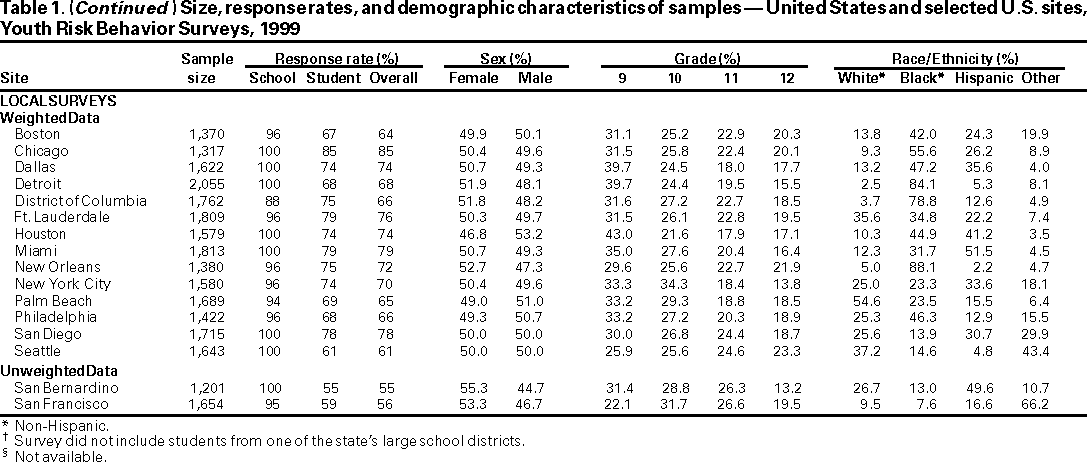 Return to top. Table 2 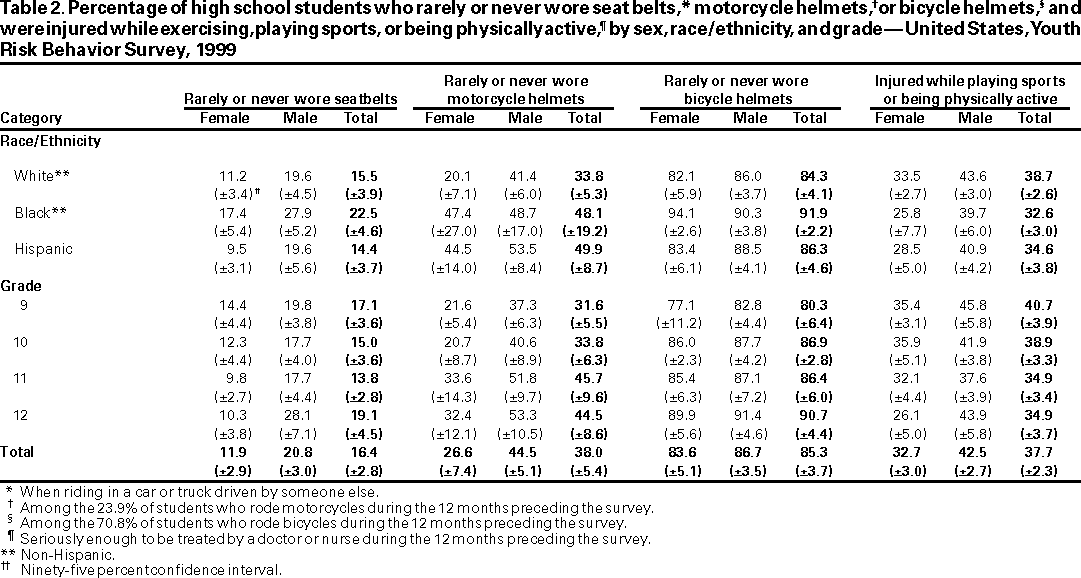 Return to top. Table 3 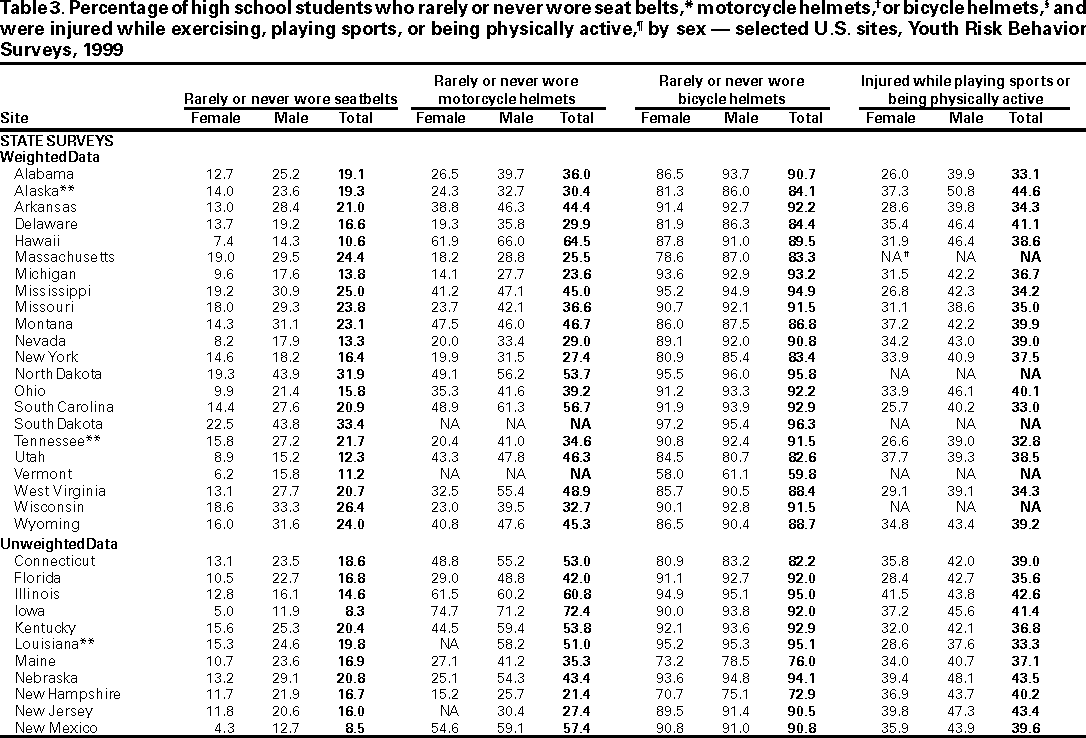  Return to top. Table 4 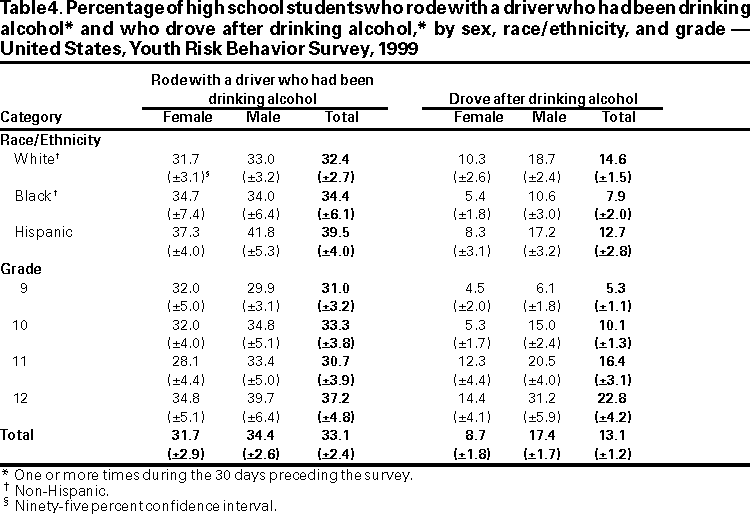 Return to top. Table 5 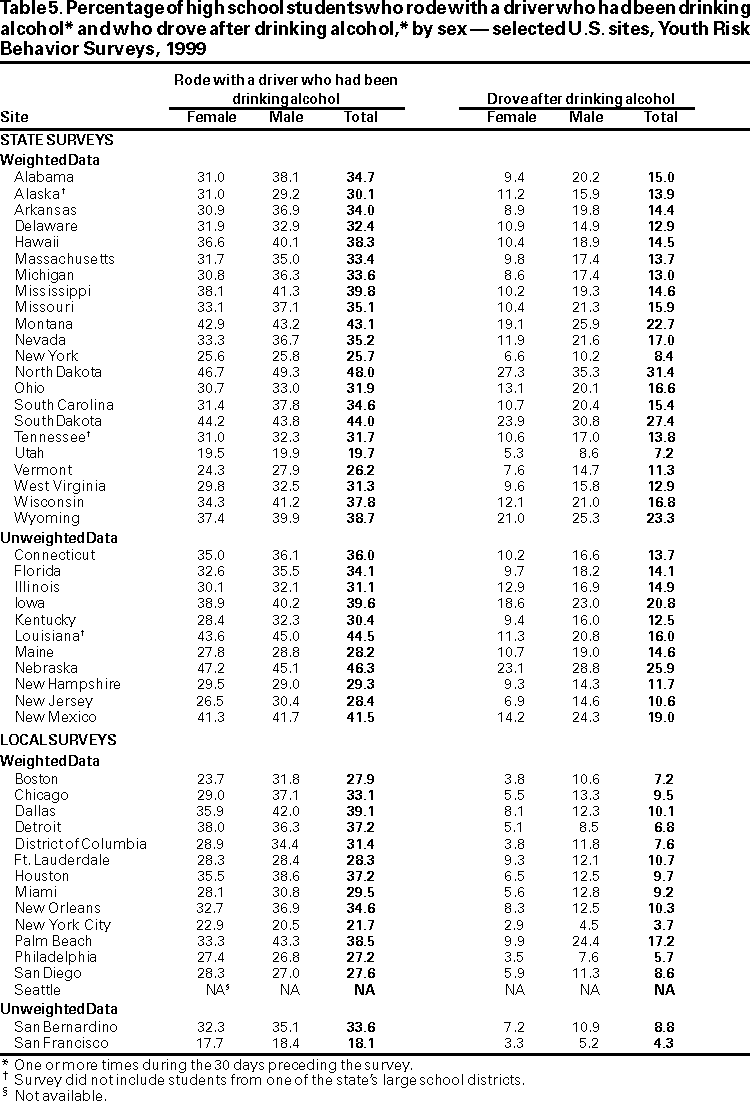 Return to top. Table 6  Return to top. Table 7   Return to top. Table 8 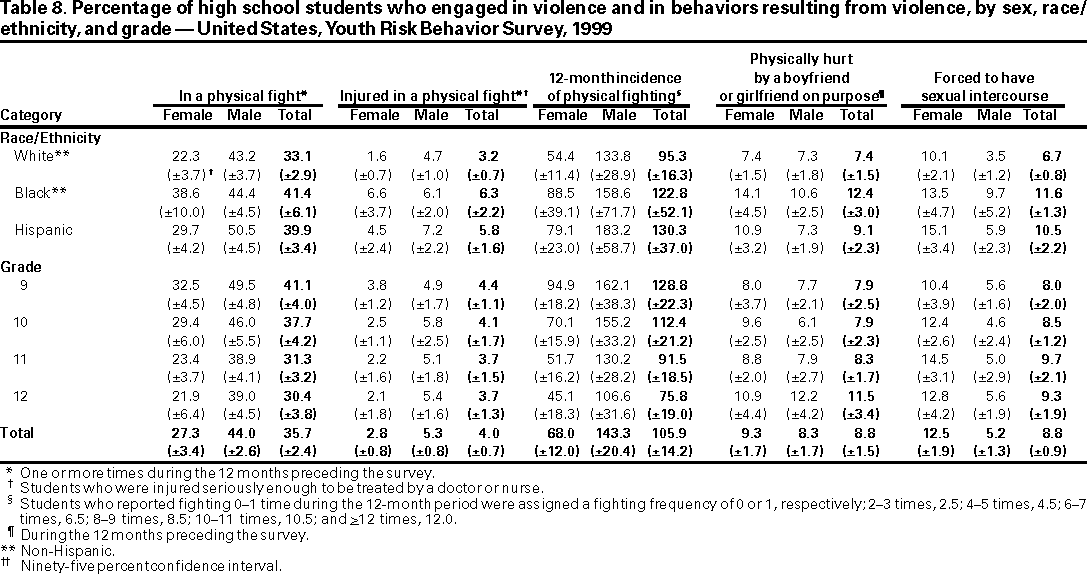 Return to top. Table 9 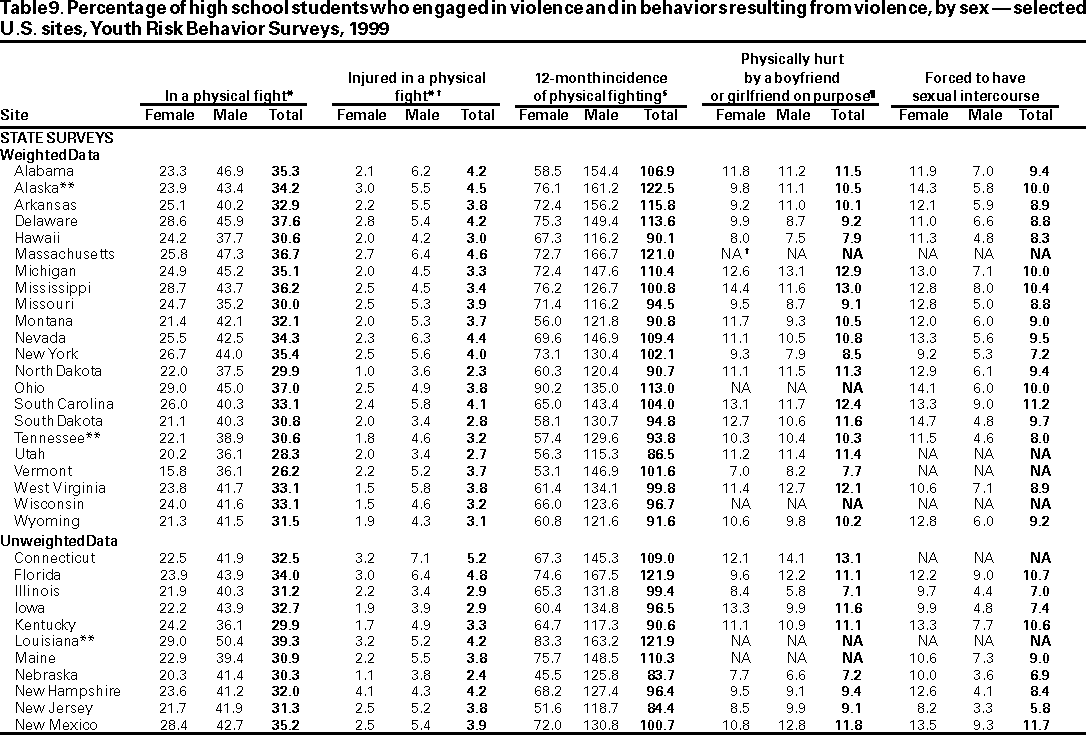 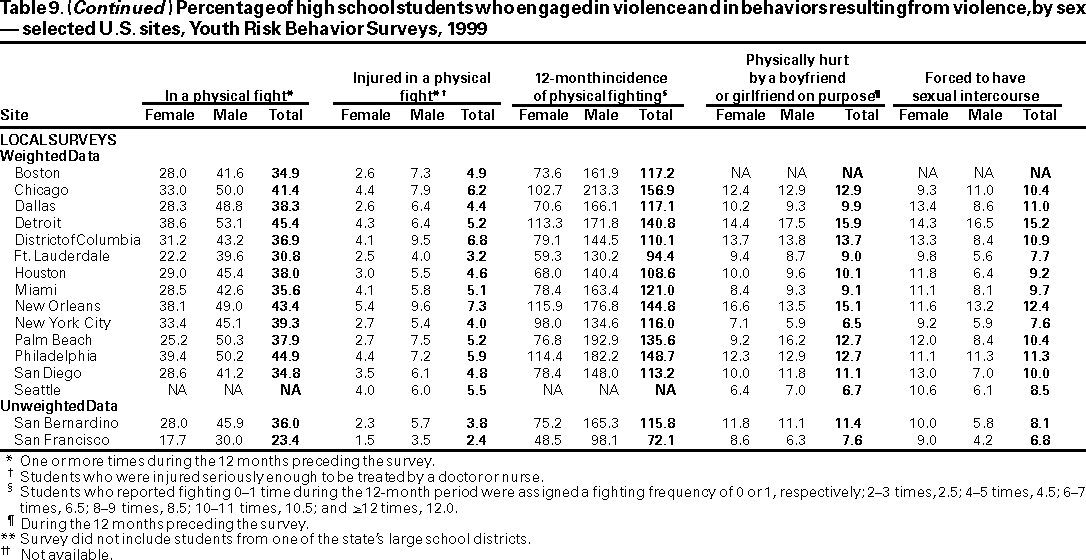 Return to top. Table 10 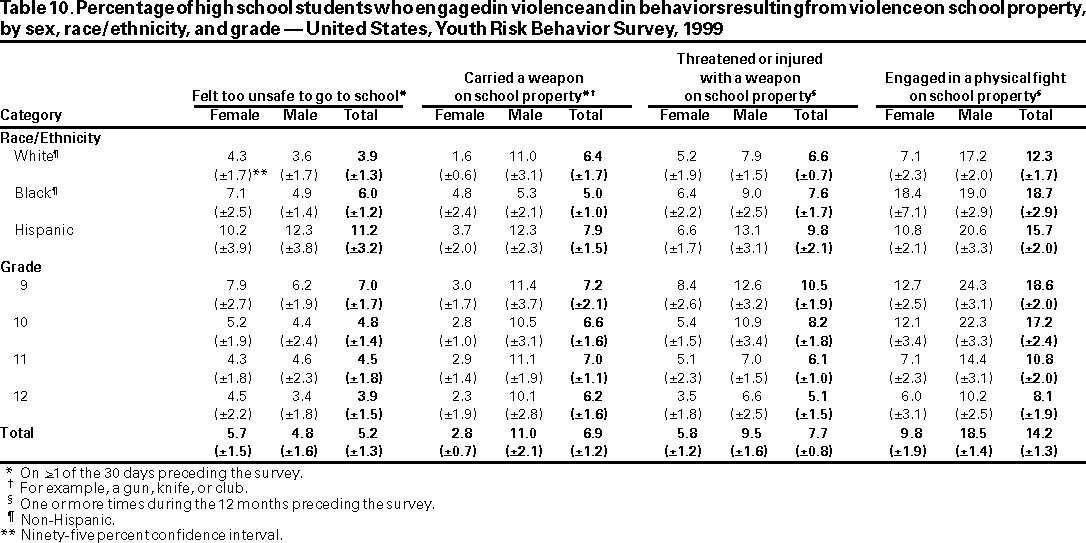 Return to top. Table 11 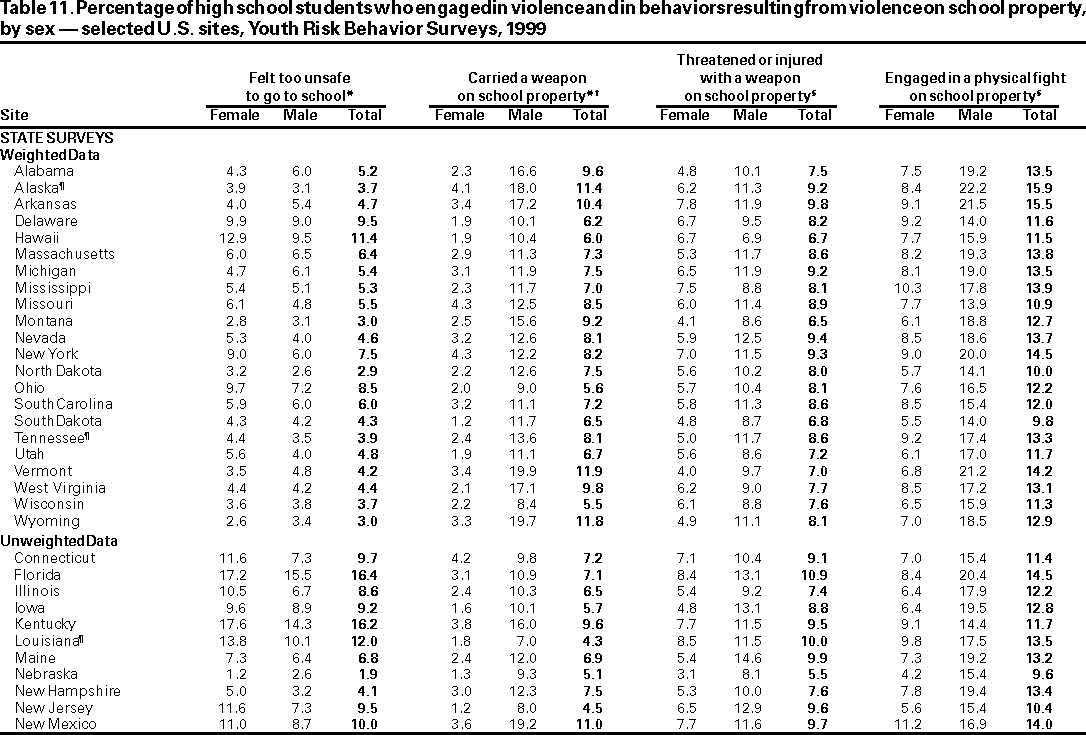 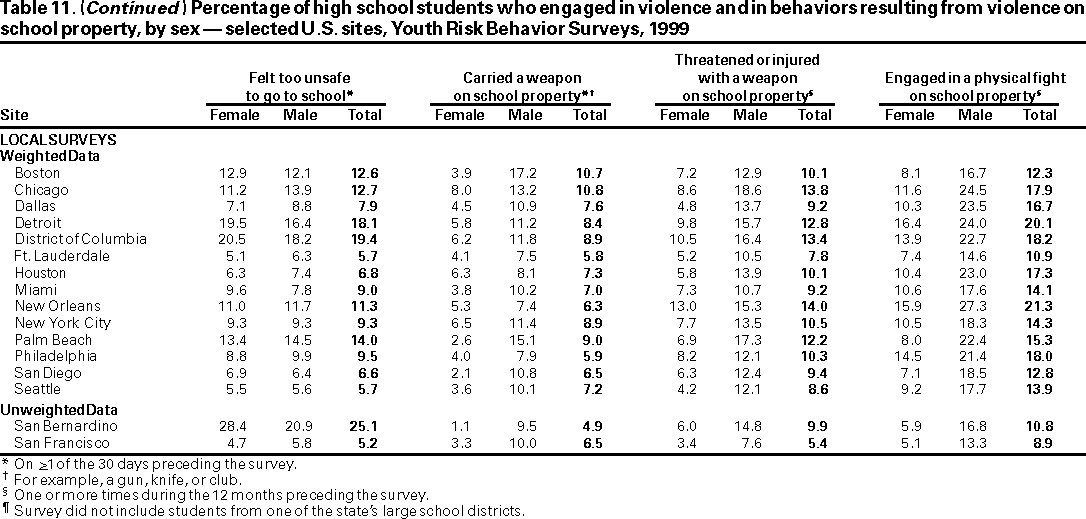 Return to top. Table 12 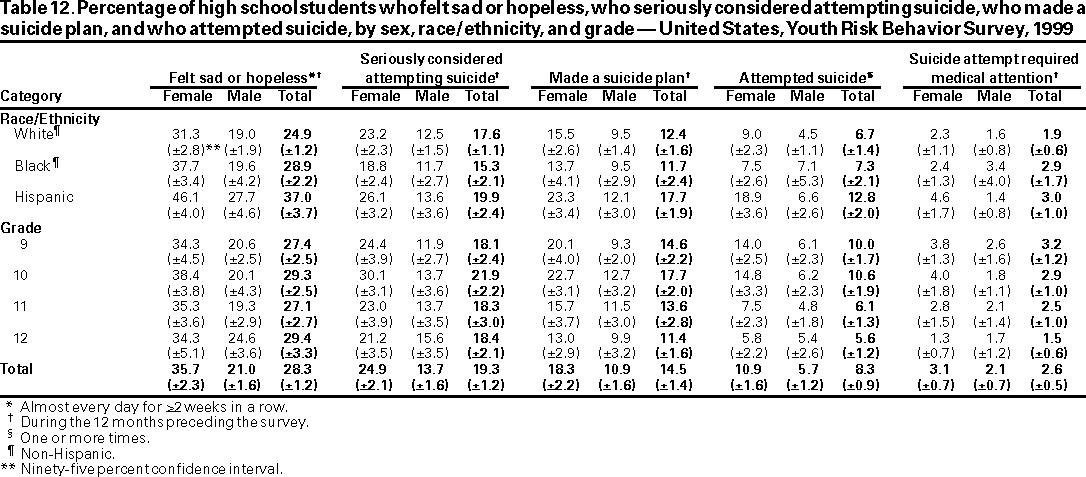 Return to top. Table 13  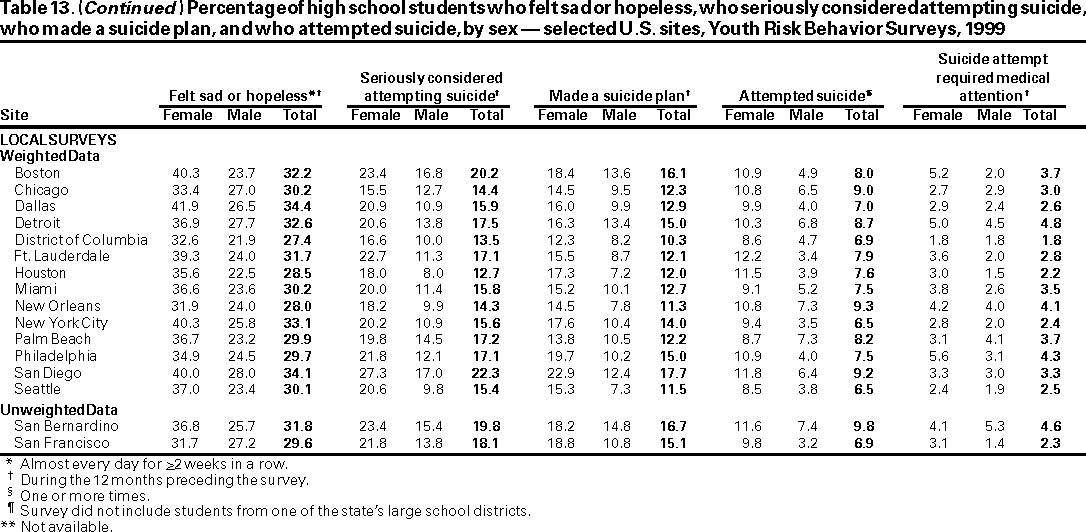 Return to top. Table 14  Return to top. Table 15 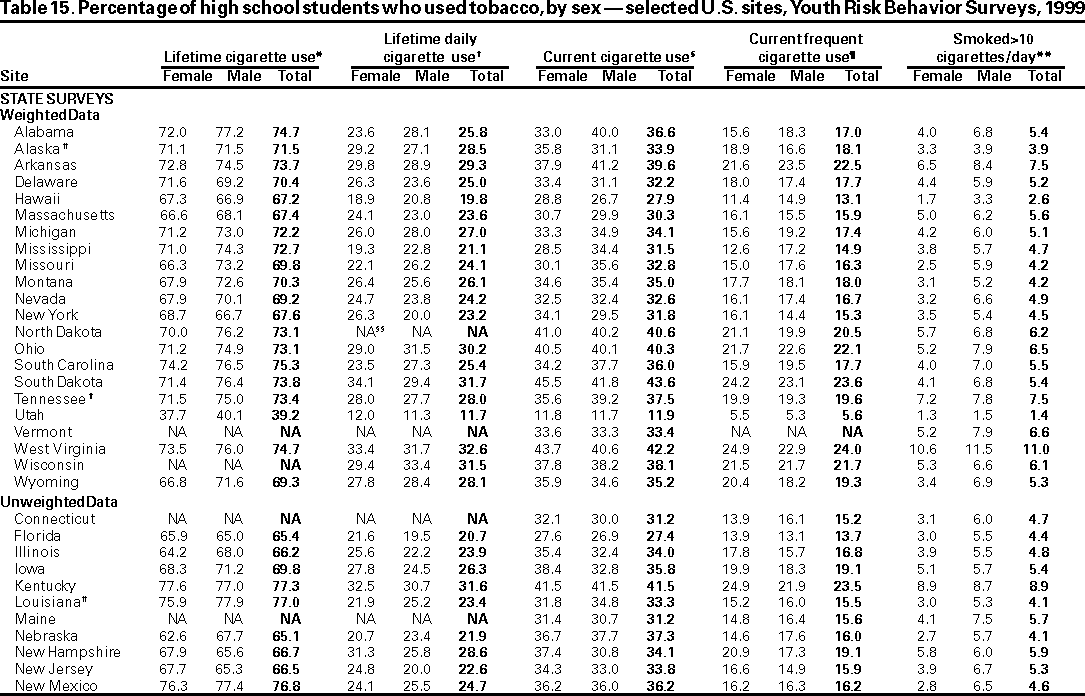 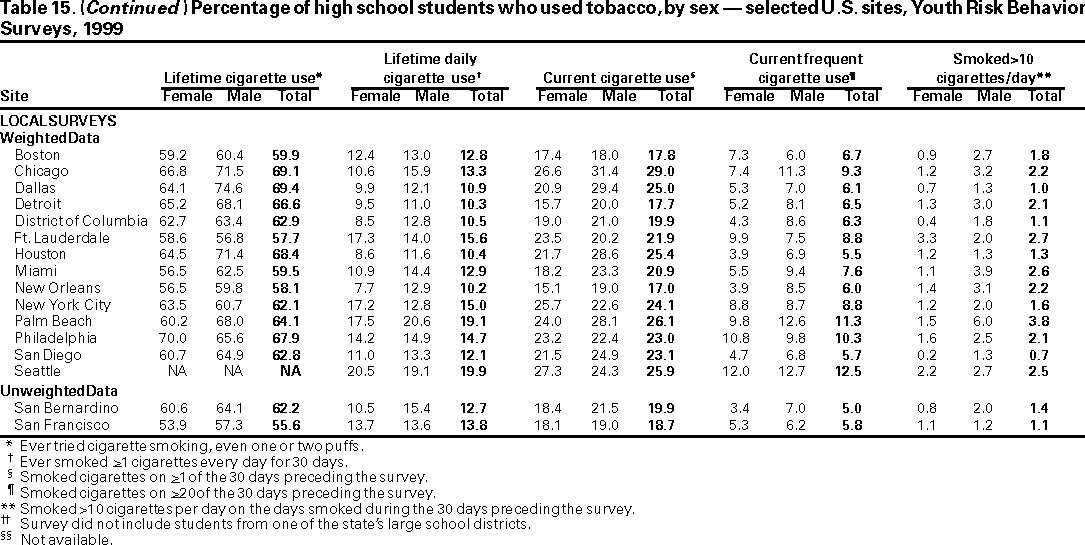 Return to top. Table 16 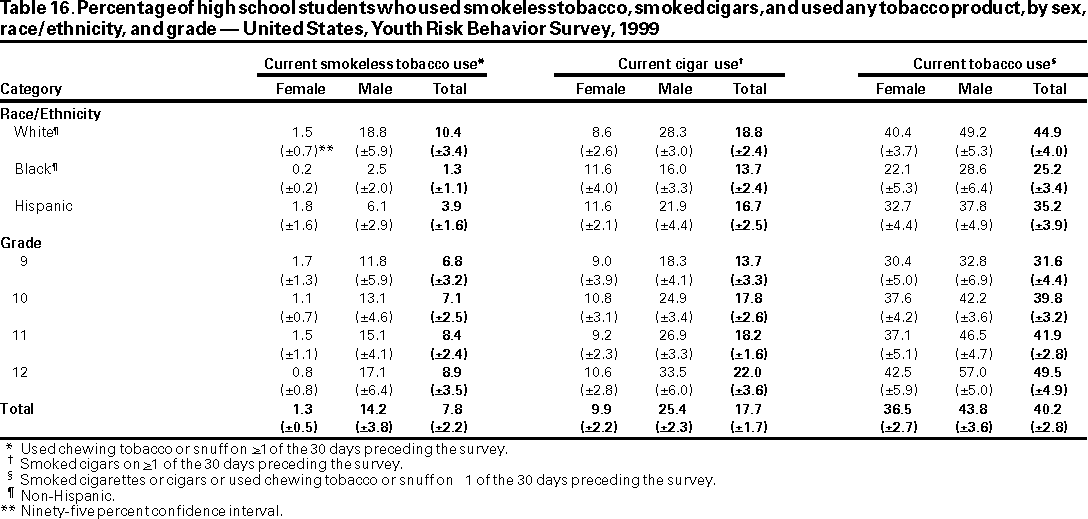 Return to top. Table 17 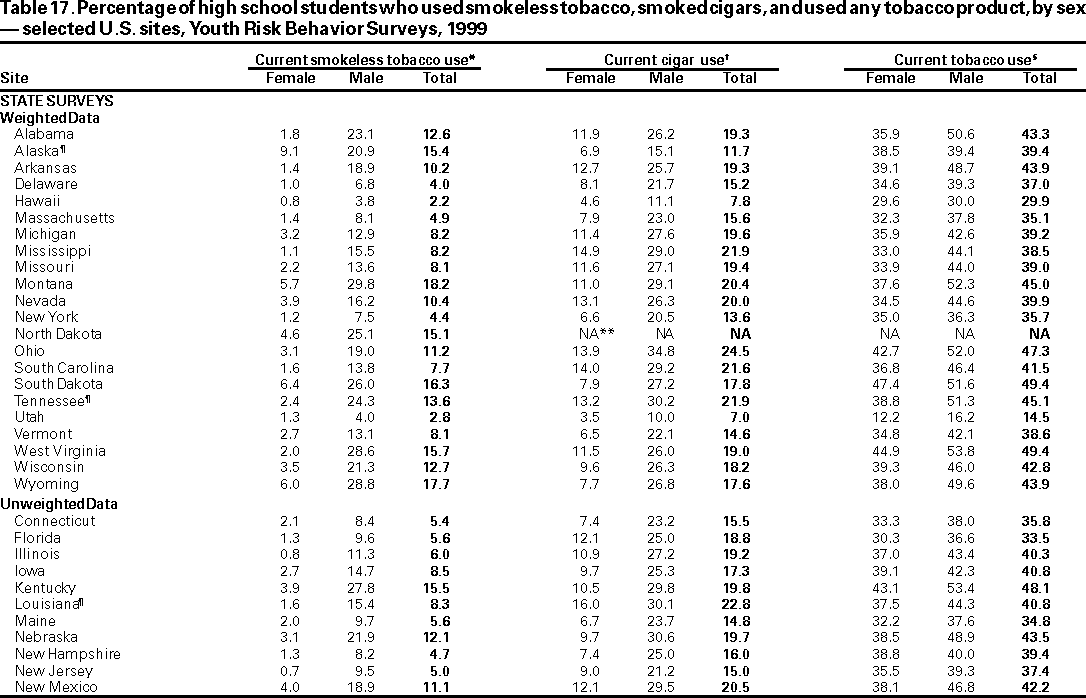 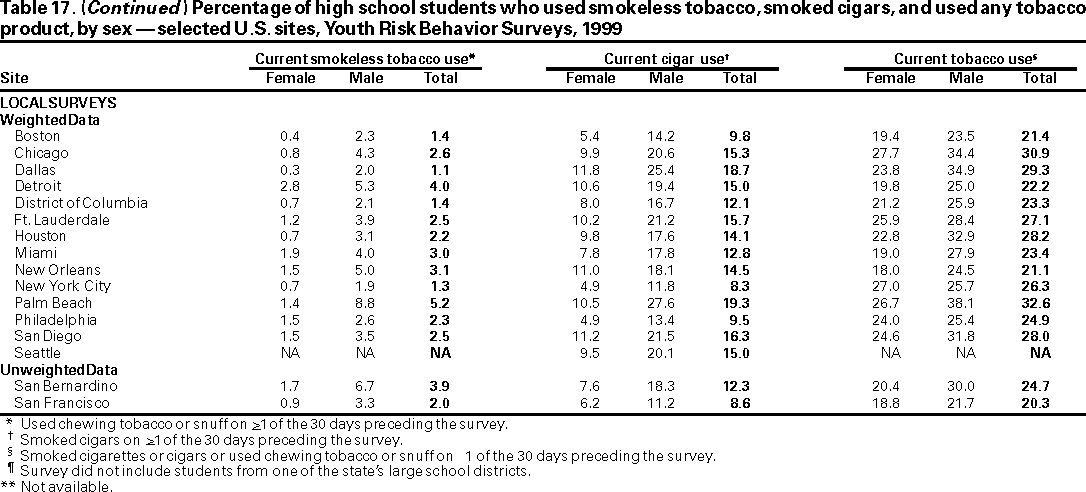 Return to top. Table 18  Return to top. Table 19 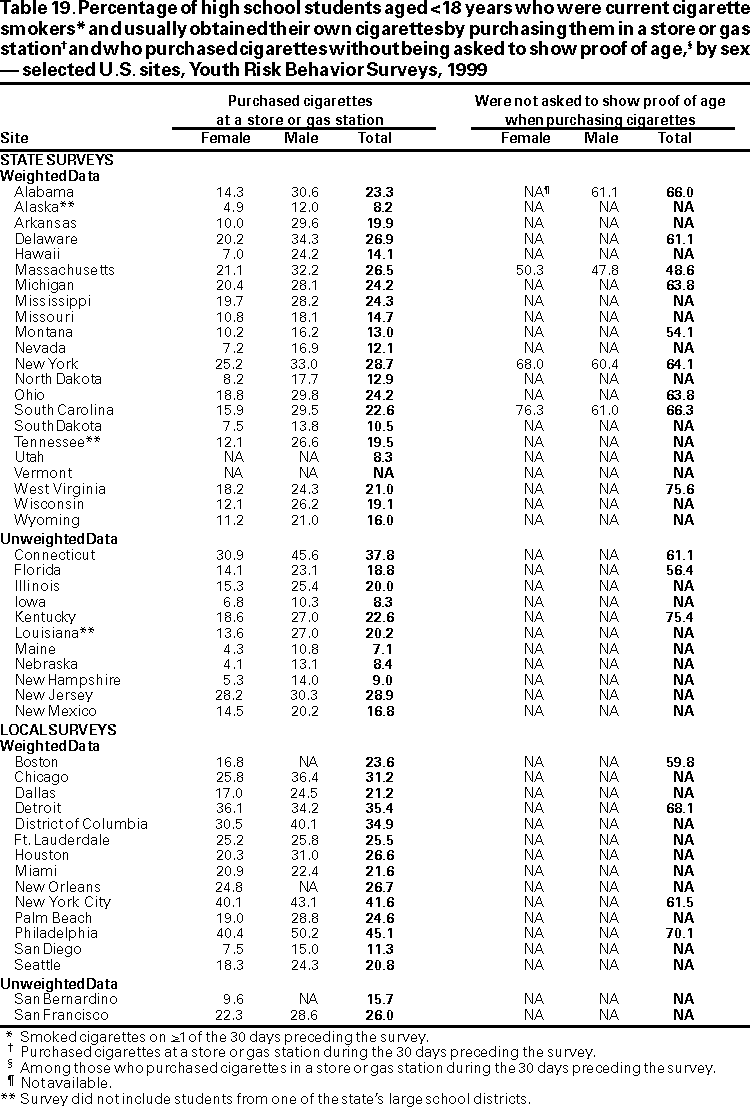 Return to top. Table 20  Return to top. Table 21 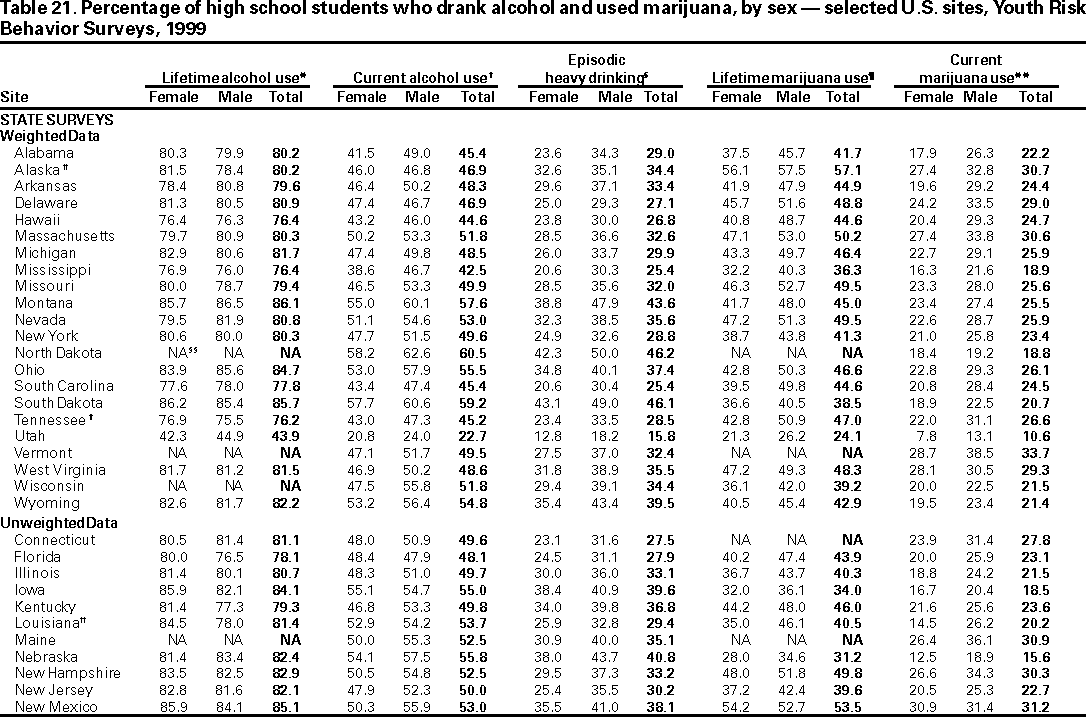 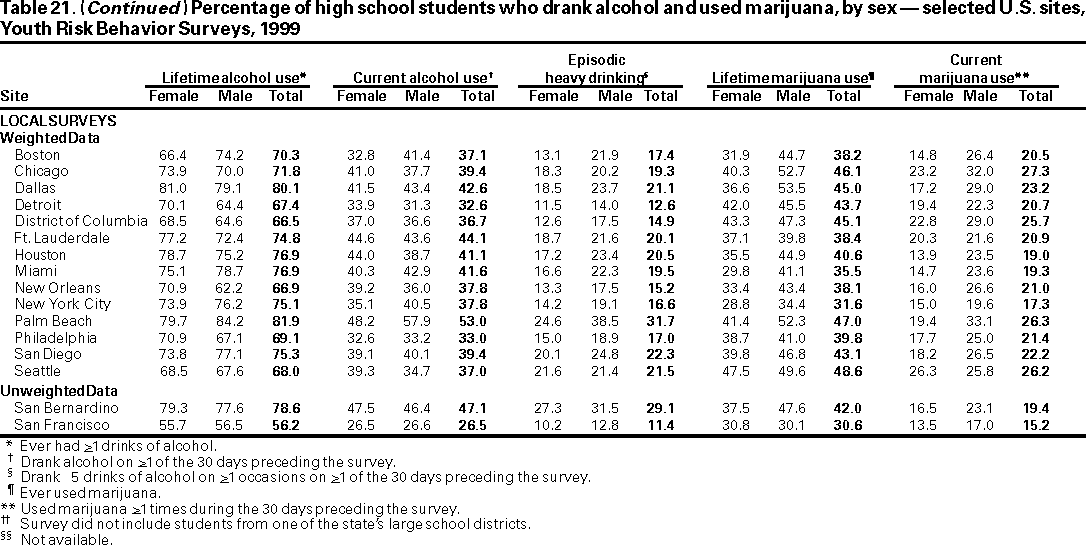 Return to top. Table 22  Return to top. Table 23 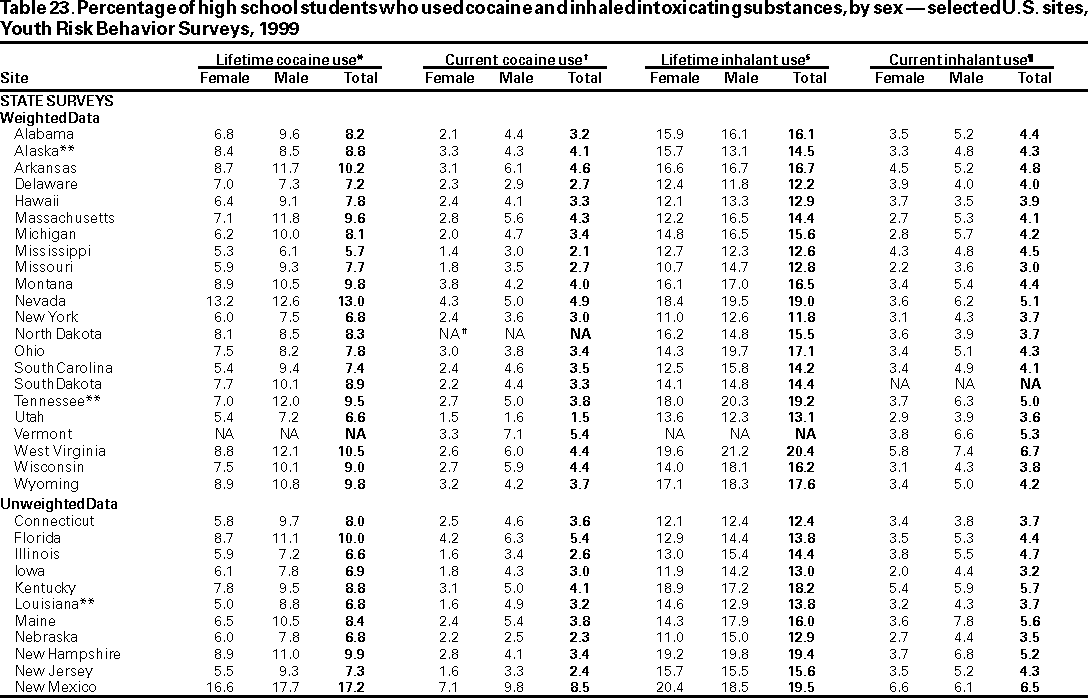 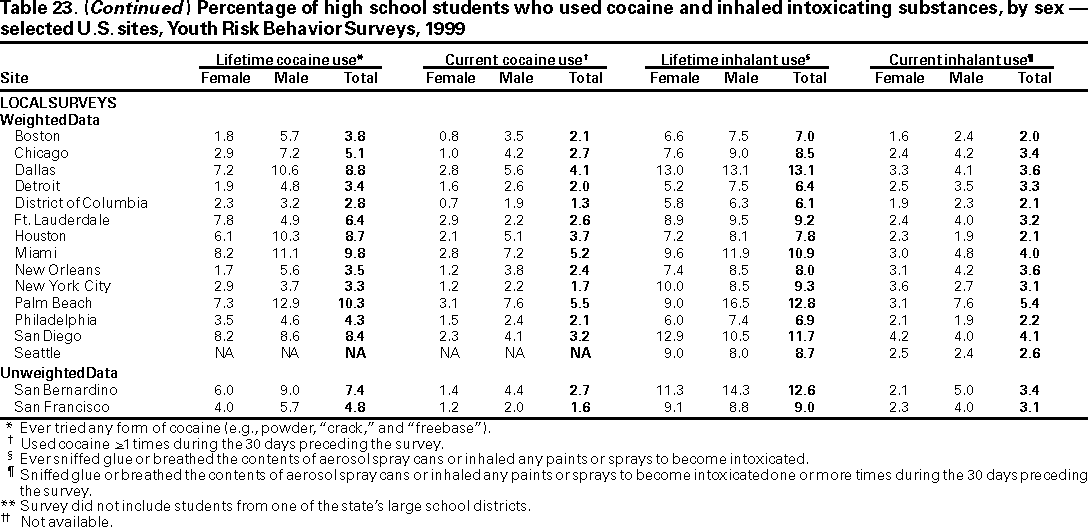 Return to top. Table 24 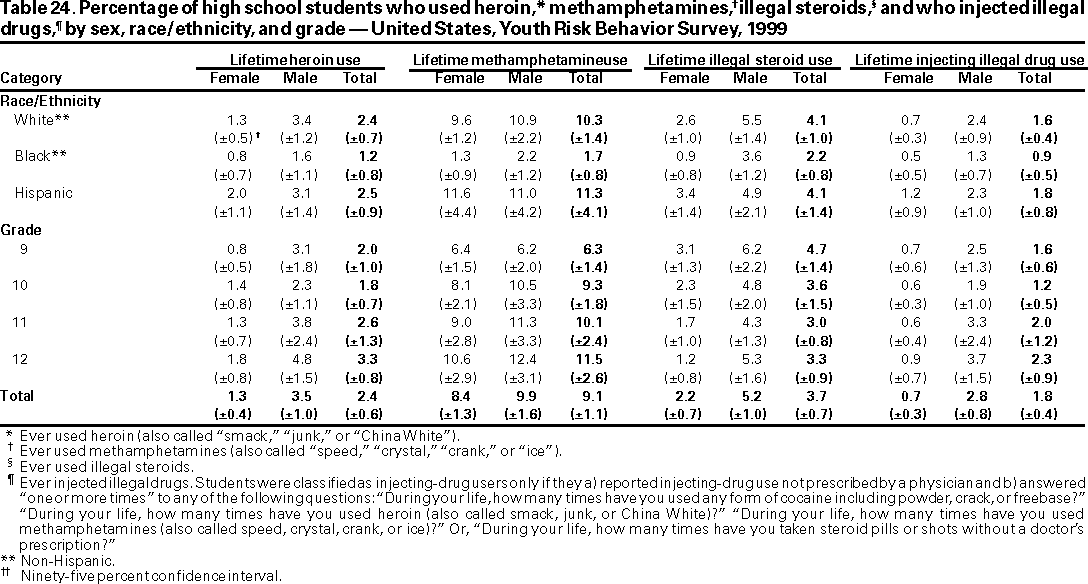 Return to top. Table 25 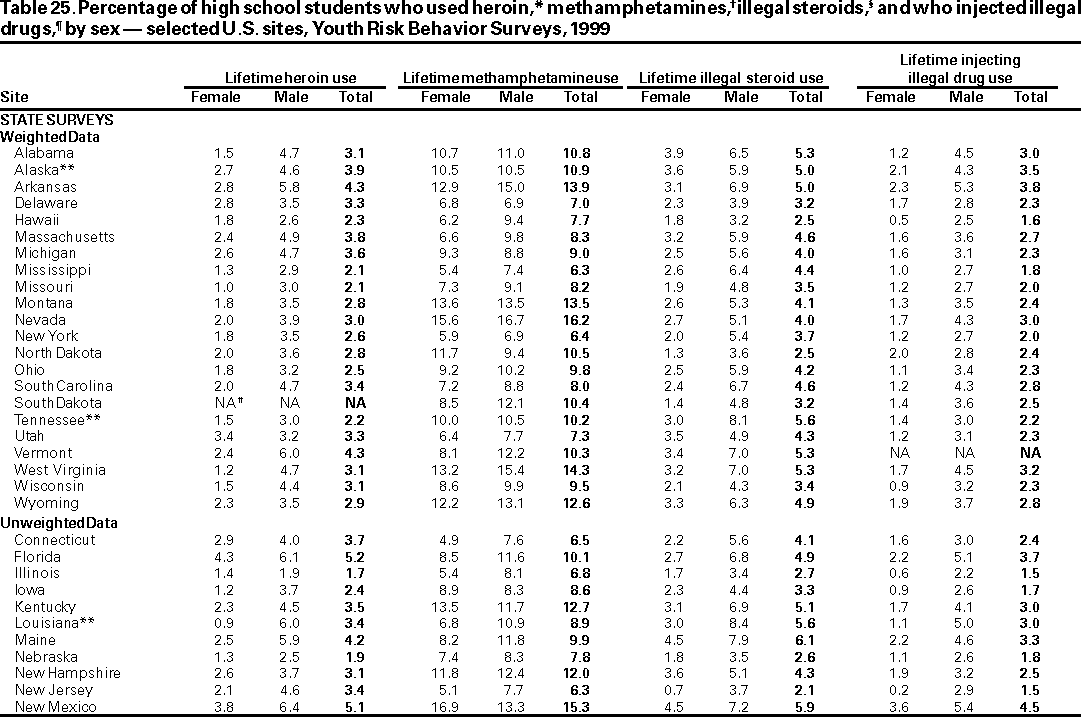  Return to top. Table 26 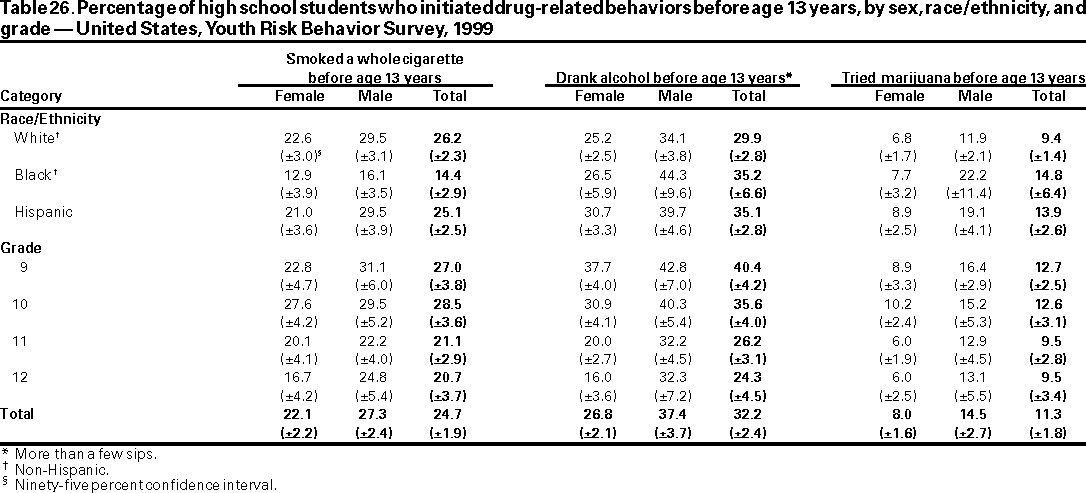 Return to top. Table 27  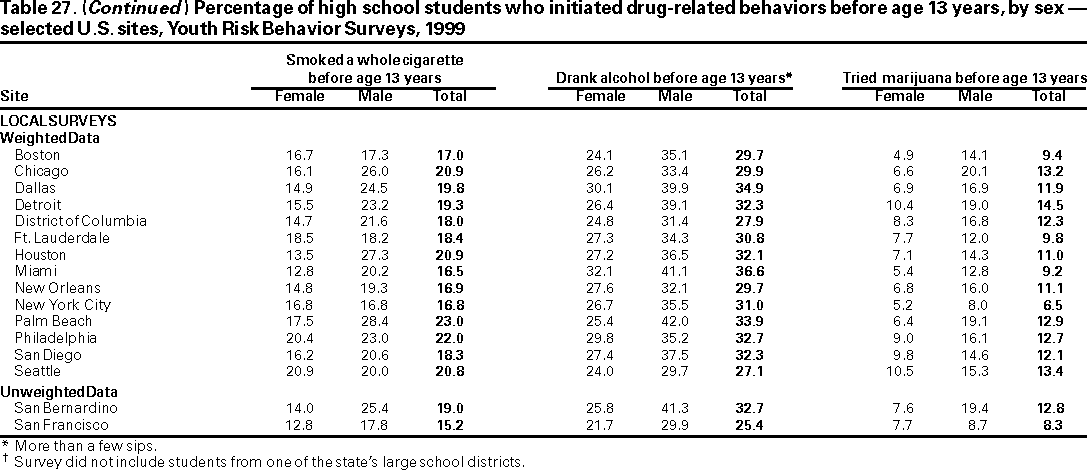 Return to top. Return to top.
Table 28 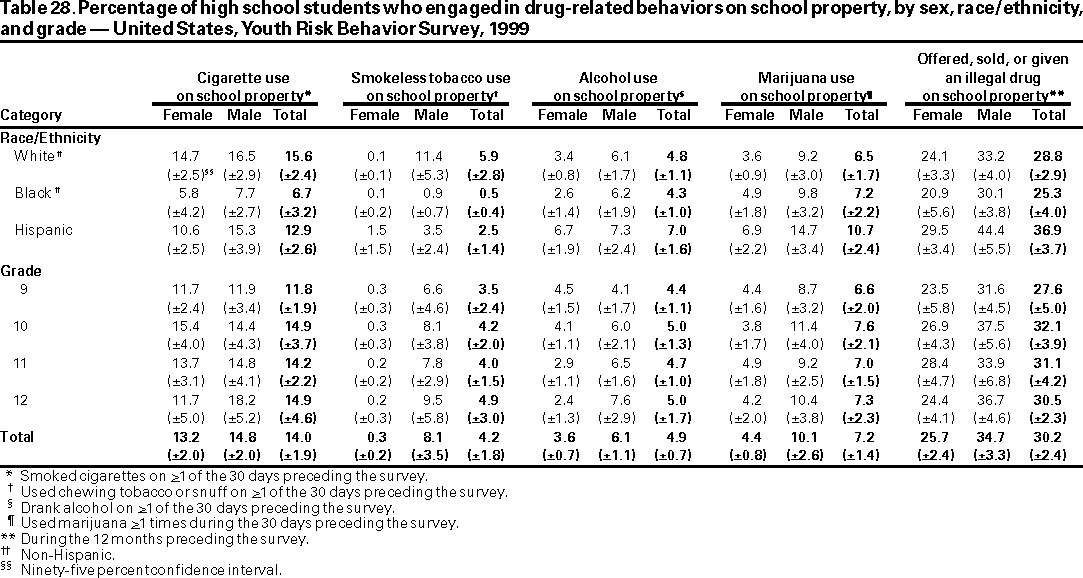 Return to top. Table 29  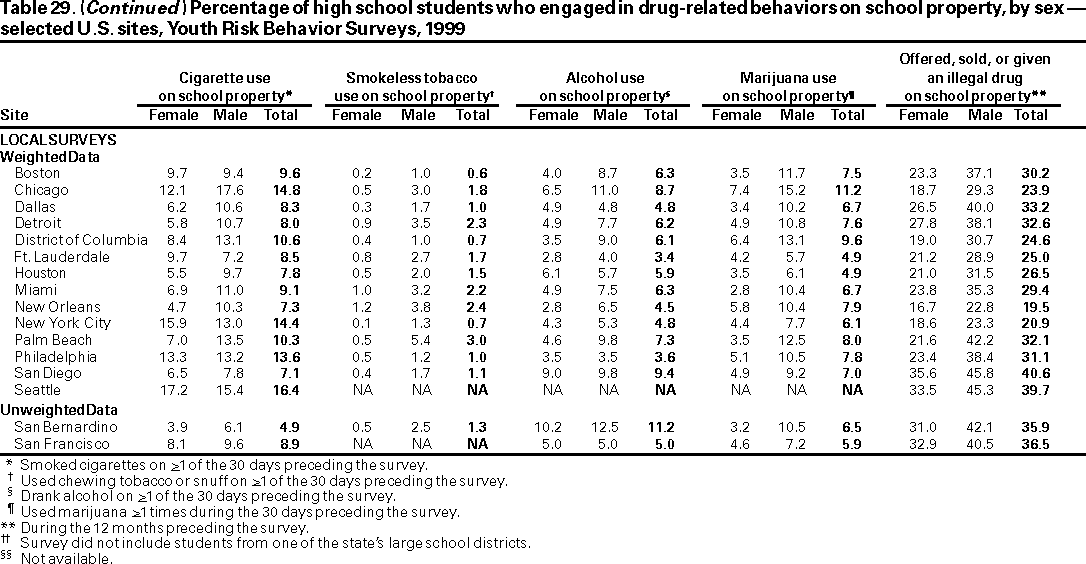 Return to top. Table 30 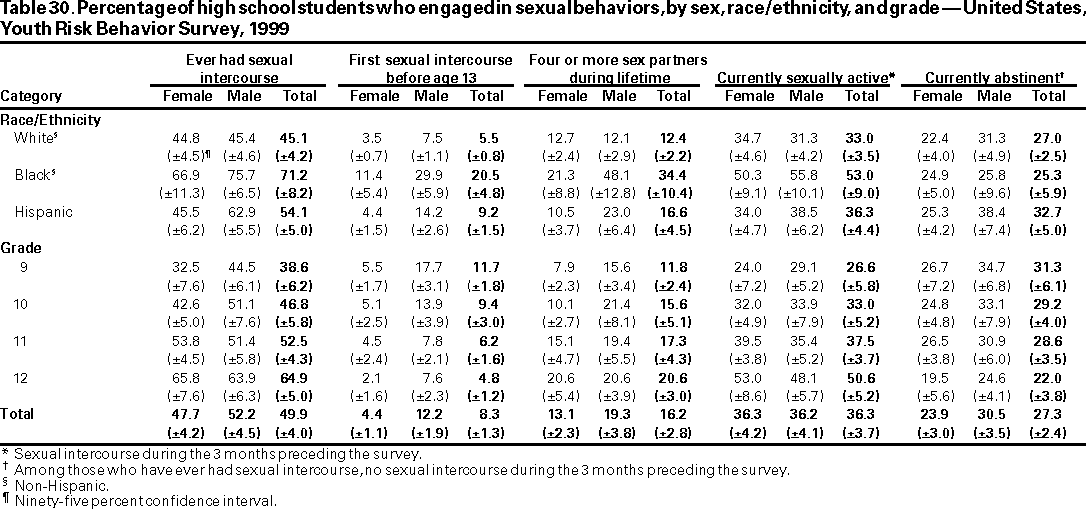 Return to top. Table 31 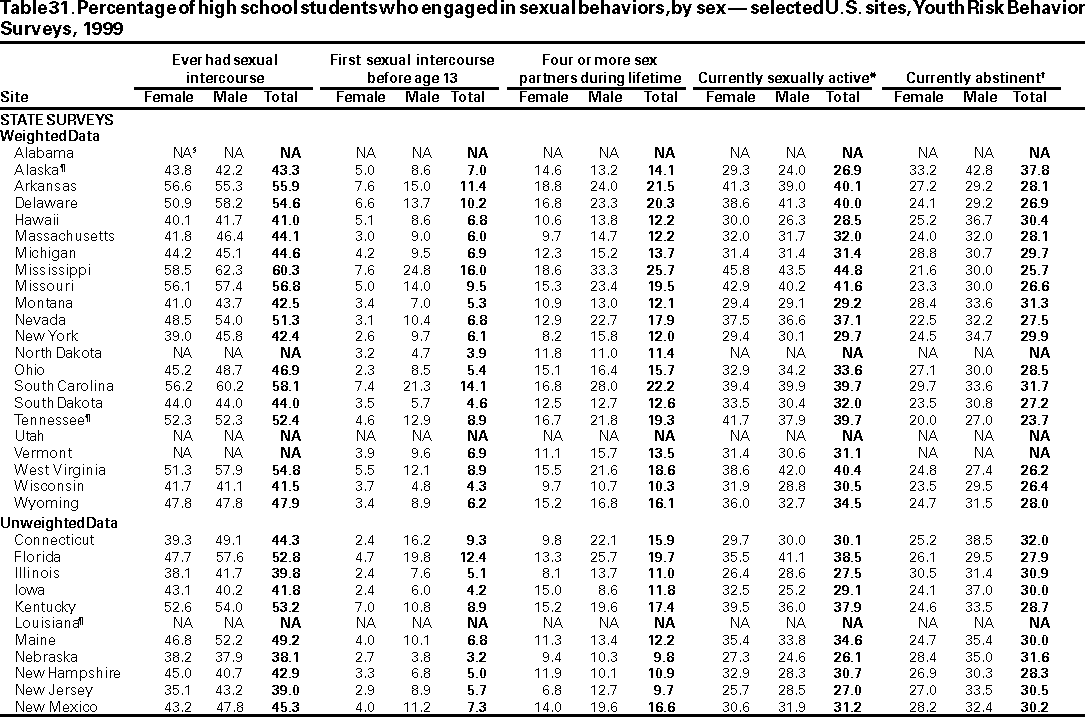 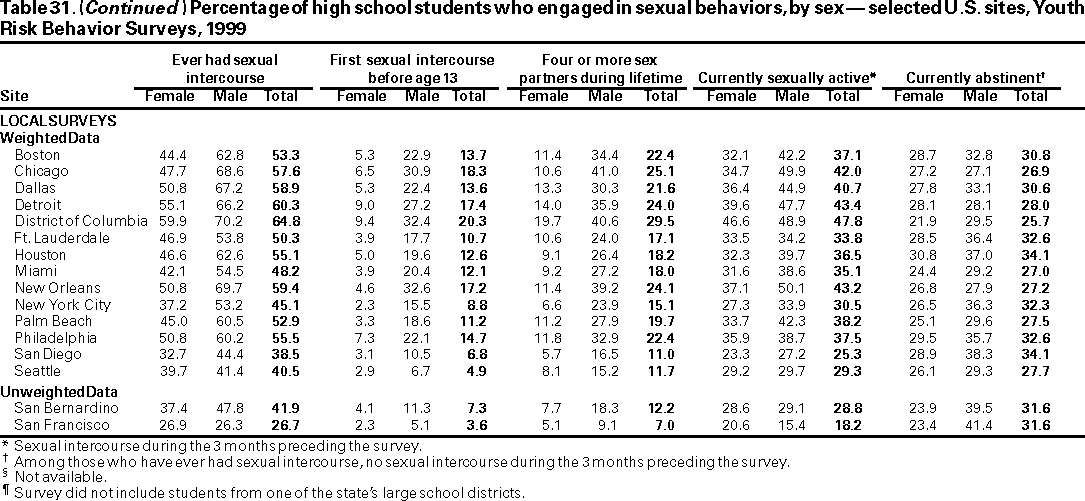 Return to top. Table 32 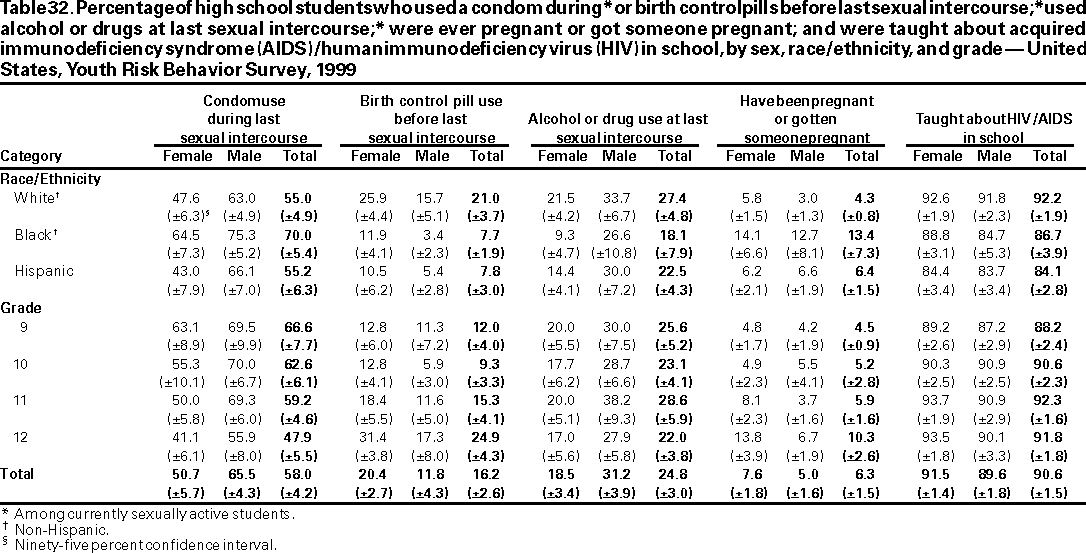 Return to top. Table 33 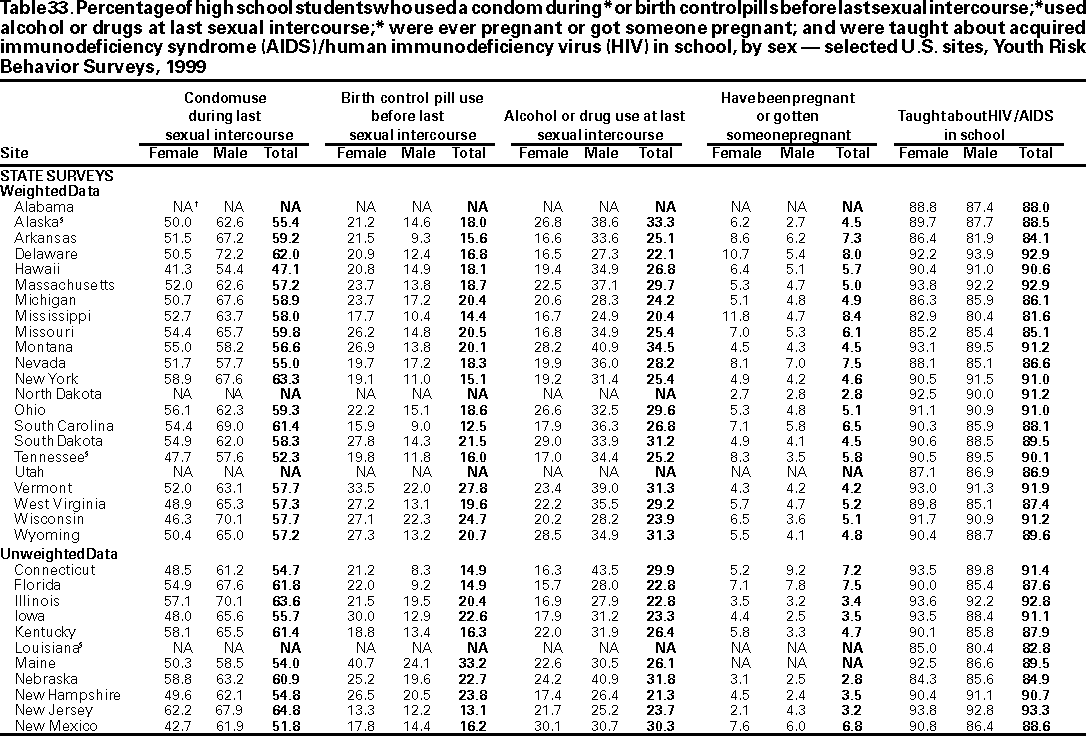 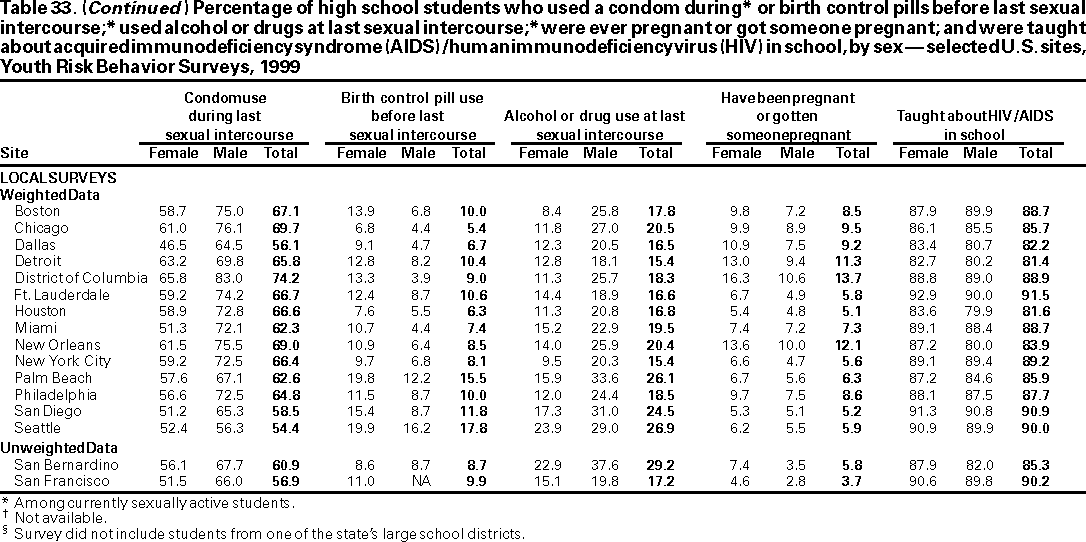 Return to top. Table 34 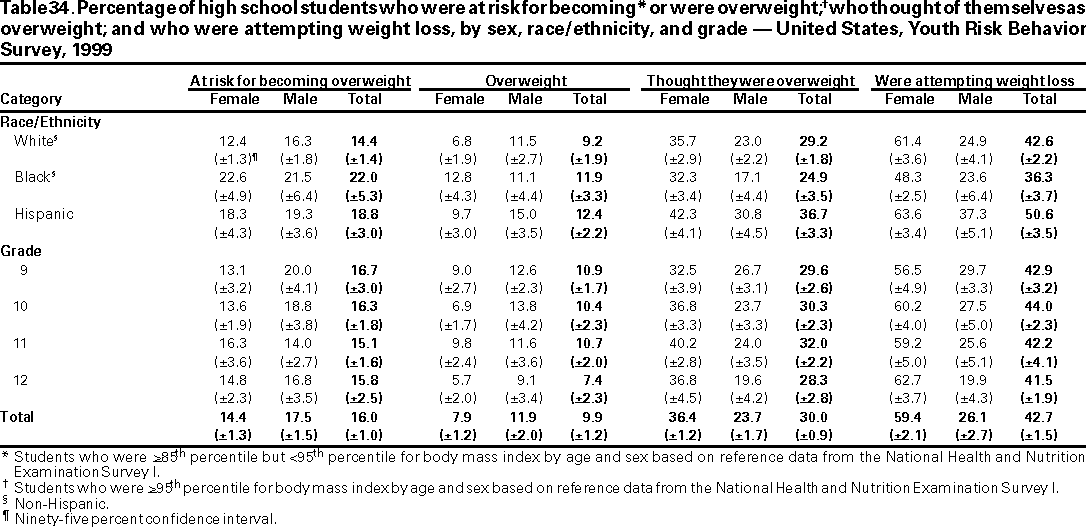 Return to top. Table 35 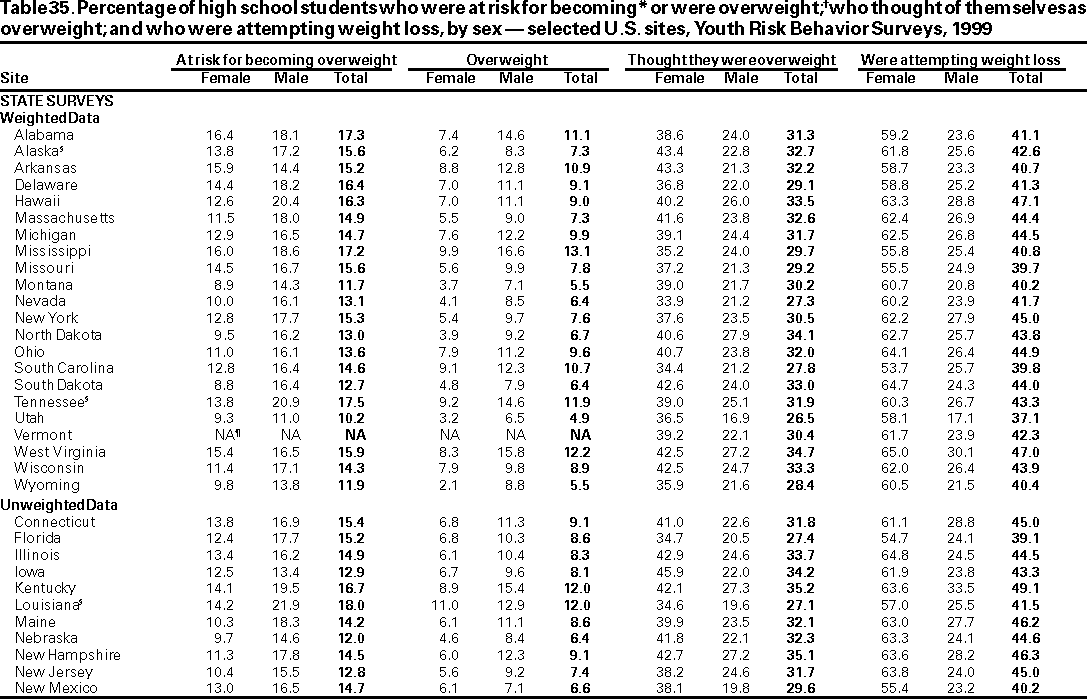 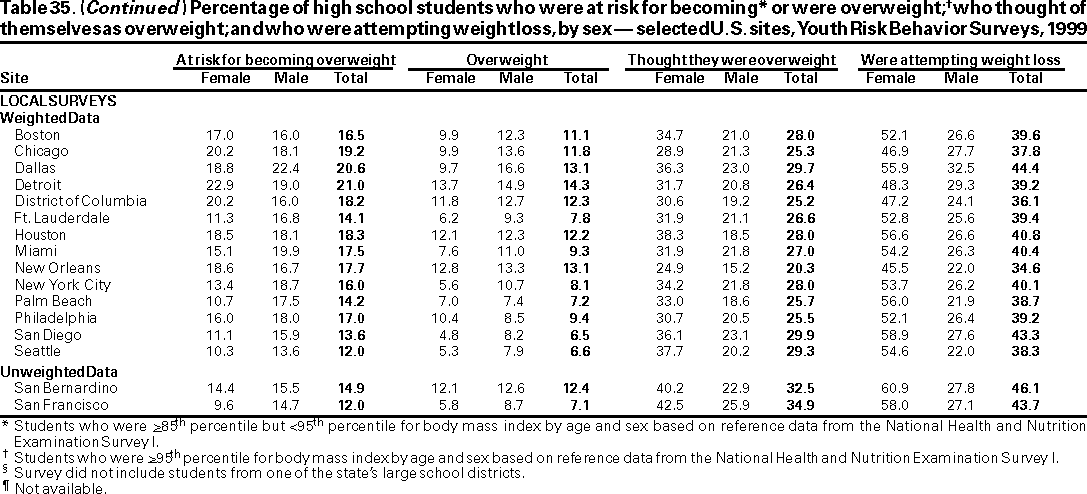 Return to top. Table 36 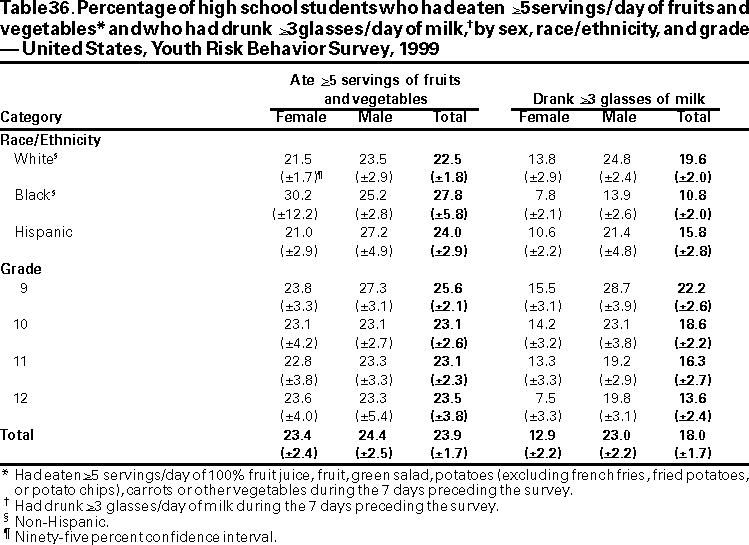 Return to top. Table 37  Return to top. Table 38 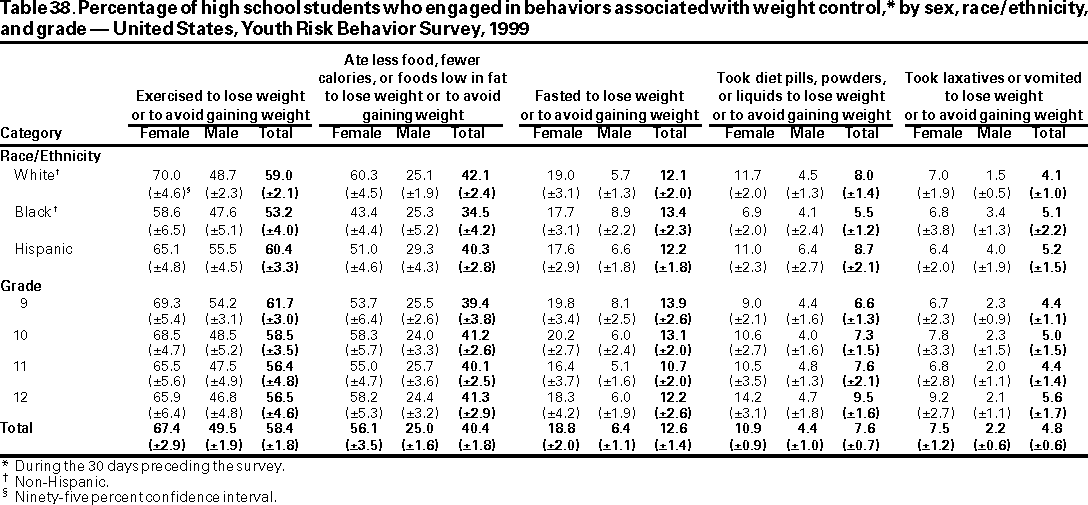 Return to top. Table 39 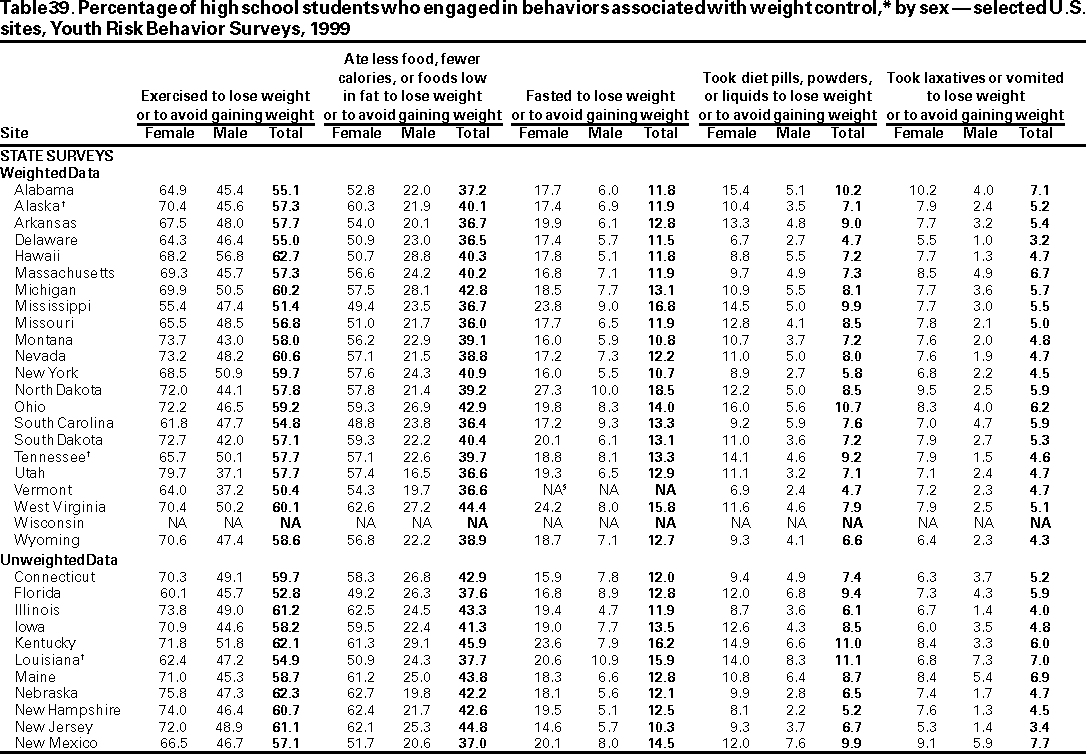  Return to top. Table 40  Return to top. Table 41 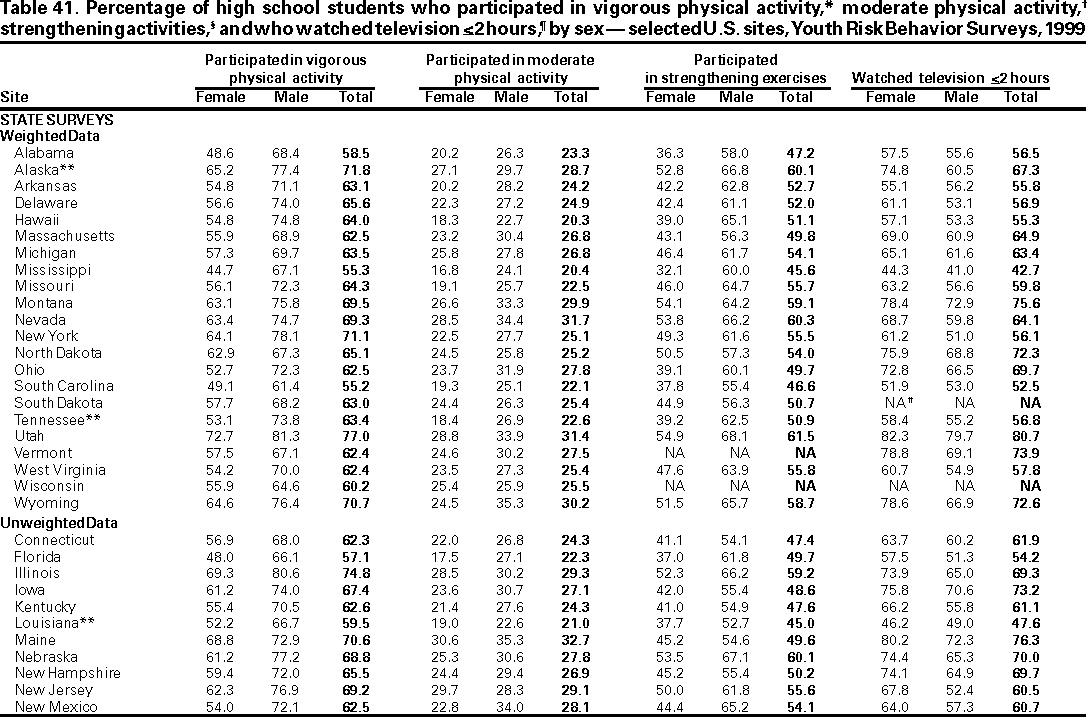 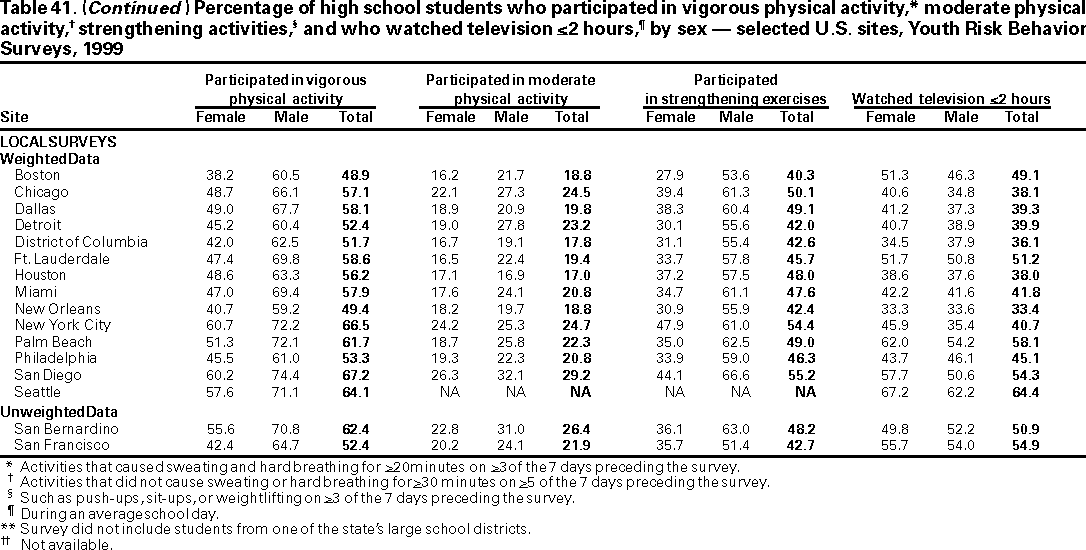 Return to top. Table 42 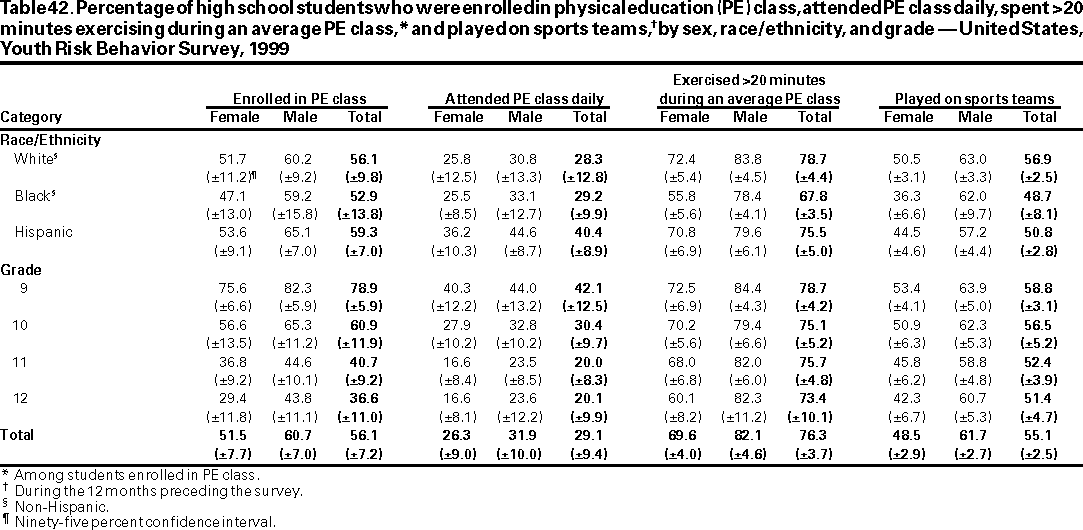 Return to top. Table 43  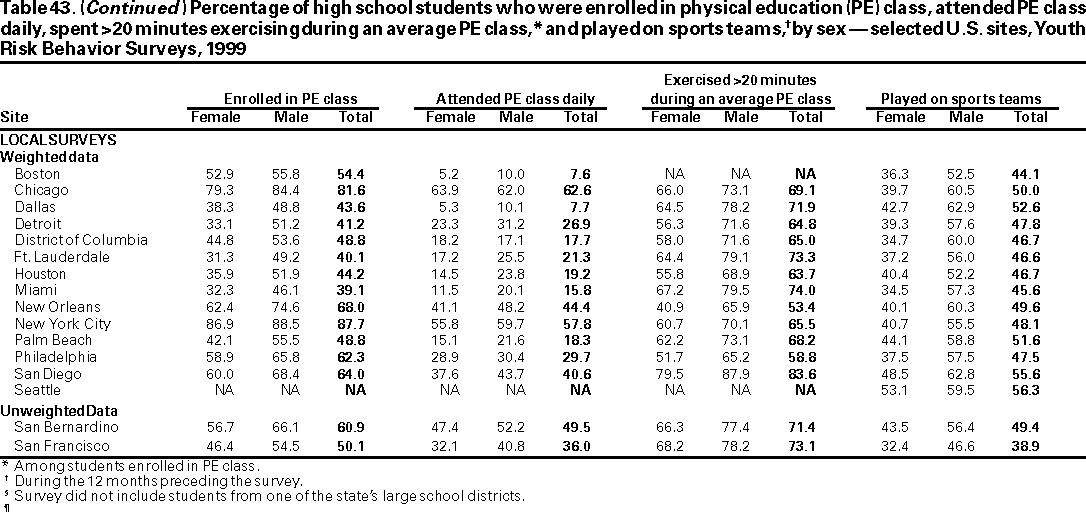 Return to top. All MMWR HTML versions of articles are electronic conversions from ASCII text into HTML. This conversion may have resulted in character translation or format errors in the HTML version. Users should not rely on this HTML document, but are referred to the electronic PDF version and/or the original MMWR paper copy for the official text, figures, and tables. An original paper copy of this issue can be obtained from the Superintendent of Documents, U.S. Government Printing Office (GPO), Washington, DC 20402-9371; telephone: (202) 512-1800. Contact GPO for current prices. **Questions or messages regarding errors in formatting should be addressed to mmwrq@cdc.gov.Page converted: 6/8/2000 |
||||||||||||||||||||||||||||||||||||||||||||||||||||||||||||||||||||||||||||||||||||||||||||||||||||||||||||||||||||||||||||||||||||||||||||||||||||||||||||||||||||||||||||||||||||
This page last reviewed 4/2/2001
|